1870 –1939 for Cambridge International AS Level History
MULTI-COMPONENT SAMPLE


















1870 –1939 for Cambridge International AS Level History
MULTI-COMPONENT SAMPLE

















Dear Teacher,
Welcome to the new edition of our Cambridge International AS Level History series, providing support for the new syllabus for examination from 2027. This series has been designed to flexibly meet all your teaching needs, including extra support for the new assessment. This preview will help you understand how the coursebook and the teacher’s resource work together to best meet the needs of your classroom, timetable and students.
This Executive Preview contains sample content from the series, including:
• A guide explaining how to use the series
• A guide explaining how to use each resource
In developing this new edition, we carried out extensive global research through teacher interviews and the Cambridge Panel, our online teacher research community. Teachers just like you have helped our experienced authors shape these new resources, ensuring that they meet the real teaching needs of the AS Level History classroom.
The coursebook ha s been specifically written to support English as a second language learners with key terms, a glossary and accessible language throughout. We have also provided features that help with active learning, assessment for learning and student re flection. Numerous activities and practice questions ensure your students feel con fident approaching assessment and have all the tools they need to be successful in their course.
Core to the series is the brand -new digital teacher’s resource. It will help you support your students and confidently teach to the updated AS Level History syllabus , whether you are new to teaching the subject or more experienced. For each topic there are common misconceptions to look out for, lesson and homework ideas, topic and language worksheets, suggested answers to the activities and practice questions in the coursebook s, and more. Also included are visual source files which can be displayed on screen or printed out to help your students with analysis of historical sources.
Please take five minutes to find out how our resources will support you and your students. To view the full series, you can visit our website or speak to your local sales representative. You can find their contact details here:
c cambridge.org/gb/education/ find-your-sales -consultant
Best wishes,
Biljana Savikj Commissioning Editor Cambridge University Press & Assessment
This suite of resources supports learners and teachers following the Cambridge International AS Level History syllabuses (9489/9981/9982). The components in the series are designed to work together and help learners develop the necessary knowledge and skills for studying History.












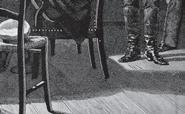

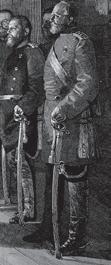

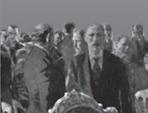
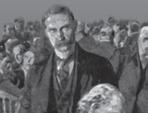




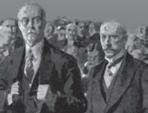
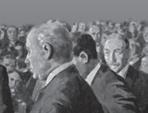

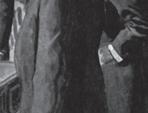




The Coursebooks are designed for learners to use in class with guidance from the teacher. One of the Coursebooks offers coverage of European Option: Modern Europe, 1774–1924 and the other offers coverage of International option: International history, 1870–1939 of the Cambridge International AS Level History syllabus. Each chapter contains in-depth explanations, definitions and a variety of activities and questions to engage learners and develop their historical skills.
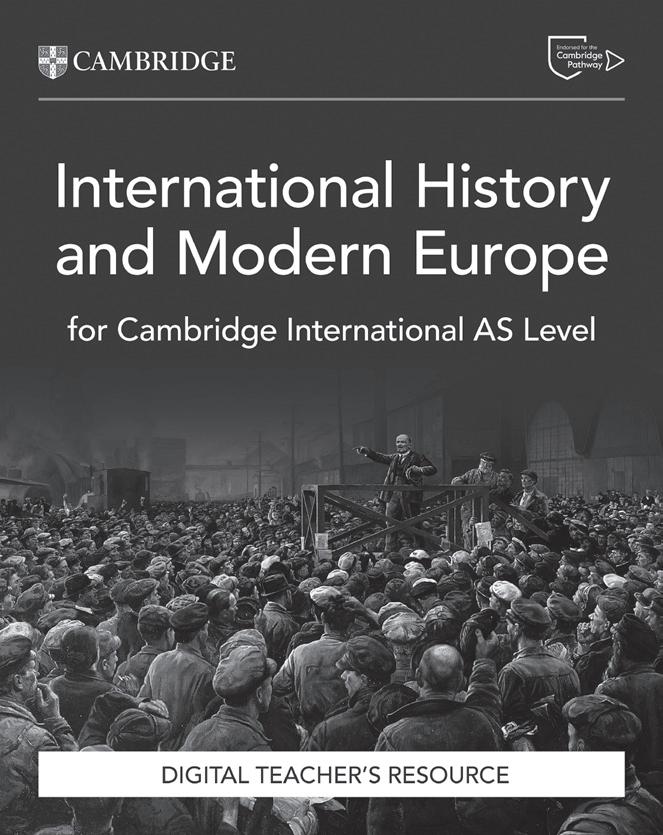
The Teacher’s Resource is the foundation of this series. It offers inspiring ideas about how to teach this course including teaching notes, how to avoid common misconceptions, suggestions for differentiation, formative assessment and language support, answers and extra materials such as worksheets and historical sources.
John Etty & Patrick Walsh-Atkins

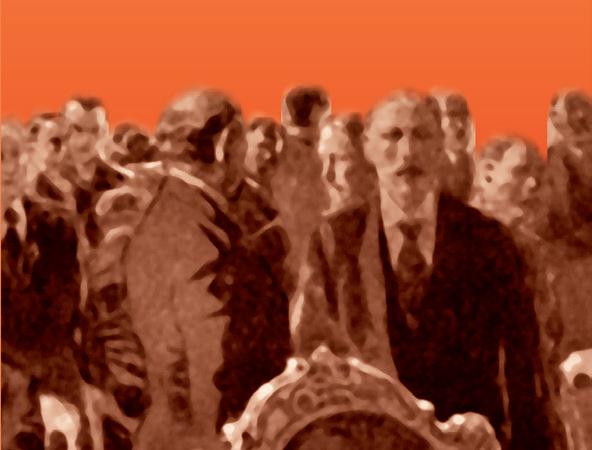

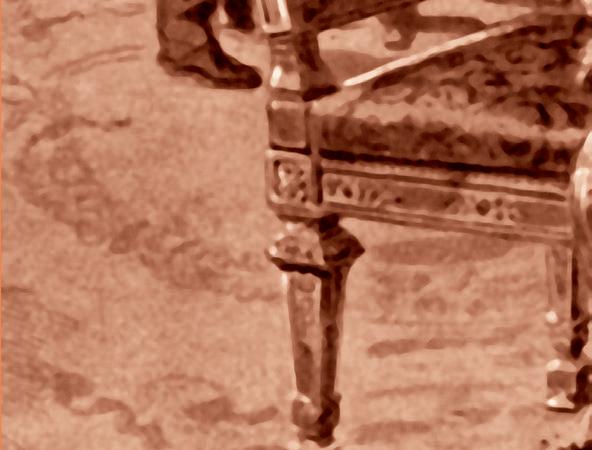


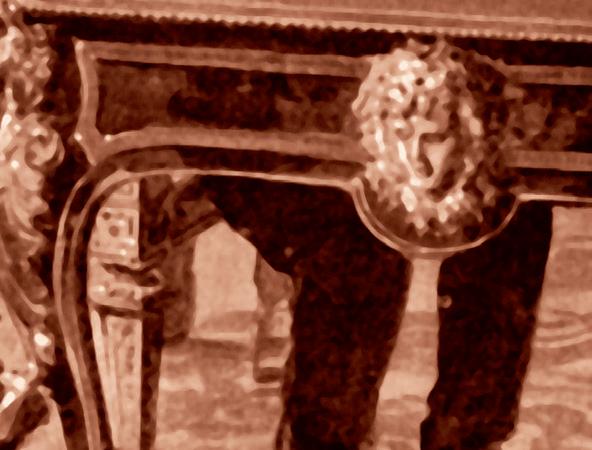







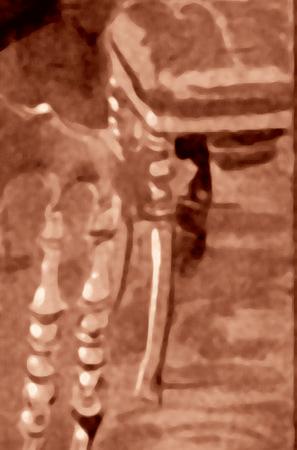
This book contains a number of features to help you in your study.
Each chapter begins with Key questions that briefly set out the topics you should understand once you have completed the chapter.
The timeline at the start of each chapter provides a visual guide to the key events which happened during the years covered by the topic.
Getting started activities will help you think what you already know about the topic of the chapter.
Activities are a mixture of individual, pair and group tasks to help you develop your skills and practise applying your understanding of a topic. Some activities use sources to help you practise your skills in analysis. Please note, some sources have been abridged or adapted.
Key terms are important terms in the topic you are learning. They are highlighted in bold where they first appear in the text, and definitions are given in the Key terms boxes. All of the key terms are included in the glossary at the end of the book.
Key concept boxes contain questions that help you develop a conceptual understanding of History, start to make judgements based on your knowledge and understanding, and think about how the different topics you study are connected.
Key figure boxes highlight important historical figures that you need to remember, and briefly explain what makes them a key figure.
Reflection boxes give you the opportunity to think about how you approach certain activities, and how you might improve this in the future.
These questions, written by the authors, help you prepare for assessment by writing longer answers.
These sample answers to some of the practice questions are accompanied by notes on what works well and how they could be improved. After reading the comments, you are challenged to write a better answer to the question.
The answers and the commentary are written by the authors.
Tips are included in the Preparing for assessment chapter. These give advice on important things to remember and what to avoid doing when revising.
Each chapter ends with a checklist of the main points covered in that topic, and gives you space to think about how confident you are with these points. Take time to fully reflect on your current level of understanding before you select an option. If you select 'Needs more work' or 'Almost there' for any of the points, revisit the relevant content and make a clear action plan for increasing your confidence in that area. It is worth revisiting the checklists when preparing for assessment.
You should be able to:
Needs more workAlmost thereReady to move on
Please be aware that this book contains some historical texts and images that may distress the reader. This material reflects the language and attitudes of the period in which they were created, but not does not align with the current values and practices of Cambridge University Press & Assessment. Teacher support is advised.
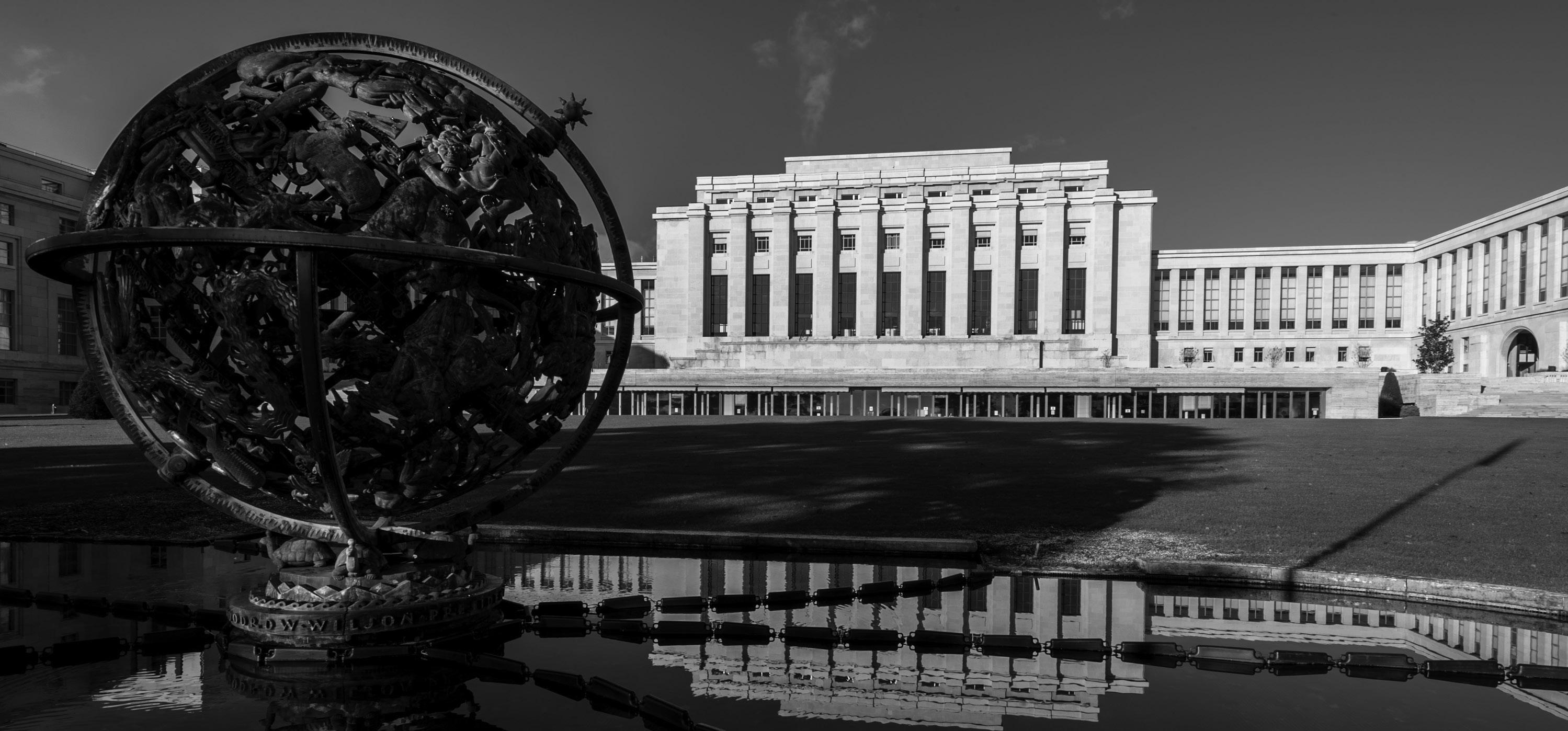
This chapter will help you to answer these questions:
•Why was there such extensive dissatisfaction with the peace settlements of 1919–20?
•Why was the League of Nations created and what challenges did it face in the 1920s?
•How and why did international tensions remain high after the Versailles settlement?
•How and why did international relations improve from 1924 to 1929?
Oct 1917
Bolshevik Revolution in Russia
Mar 1918
Treaty of Brest-Litovsk (Germany and Russia)
Oct 1918
German request for armistice
Jan 1919
Opening of the Paris Peace Conference at Versailles
Sep 1919 Treaty of Saint-Germain
Jun 1920
Treaty of Trianon
May 1921
Treaty formally ending the war between the USA and Germany
Apr 1922 Rapallo Pact (Germany and the USSR)
Aug 1924 The Dawes Plan
Aug 1928
Jun 1919
Treaty of Versailles
Jan 1918
President Wilson’s 14 Points Speech
Working in pairs or small groups
Nov 1919
Treaty of Neuilly
Jun 1920 Treaty of Sèvres
1921−22
1922 23
World Disarmament Conference
Washington Conferences
Jan 1923
French occupation of the Ruhr
Oct 1925
Locarno Conference
Kellogg–Briand Pact
Sep 1929
The Young Plan
a Using Chapter 1 (Section 1.4) and any other resources available to you, do a little background research to identify the reasons why the following countries went to war in 1914, or joined in before it ended: Germany, France, Britain, Russia, Austria-Hungary, Italy, Turkey, Japan, the USA.
b Look at the map in Figure 2.1 that shows Europe at the start of war in 1914. Now compare it with the maps in Figures 2.6 and 2.7 and identify the new countries that have been created by the peace treaties of 1919–20, which you will study in this chapter. What is the same? What is different?
In January 1919, a group of men met in the great Palace of Versailles, near Paris in France, to make the peace that ended what became known as the First World War. These men faced a challenging task. The murder in 1914 of the heir to the Austrian throne had led to a worldwide conflict. France, Britain, Russia, Italy and the USA had fought against Germany, Austria-Hungary and the Turkish Empire, from 1914 to 1918. About 20 million soldiers and about the same number of civilians had died.
The end of the war did not bring stability. The political effects of the First World War were devastating. Revolutions occurred throughout the former AustroHungarian and Turkish empires. Like the German Empire, these empires collapsed into chaos. An influenza epidemic in 1918–1919 caused a further 2.5 million deaths in Europe. During the war, Germany’s enemies had successfully prevented food from reaching into Germany and Austria-Hungary, so millions in central Europe were starving by the end of 1918. Serious social unrest was breaking out in countries such as Italy, Germany and Hungary and there were fears of revolution. Several million refugees were now in search of homes and security. The winning allies had to adjust their economies from making weapons to more peaceful products and they also owed $176 billion, mainly to the United States, which they had borrowed to pay for the war.
Meanwhile, revolution had already taken place in Russia in 1917 (see Chapter 1, Section 1.3). Russia had initially taken part in the war on the Allied side. In October 1917, led by Vladimir Lenin and Leon Trotsky, the Bolshevik party had overthrown the Russian government and set up a new government based on communism. The new revolutionary government had withdrawn from the war, by signing the Treaty of Brest-Litovsk with Germany in December 1918. The terms of the treaty were extremely harsh. Russia lost large areas of territory, including areas containing much of its best farmland, raw materials and heavy industry. Russia lost 25% of its population, 25% of its industry and 90% of its coal mines. Later, in 1918, countries still fighting Germany remembered these huge penalties that Germany had imposed on Russia for being the ‘losers’ in their war.
By the end of 1918, Lenin and the Bolsheviks were engaged in the Russian Civil War against other revolutionary parties and supporters of the Russian monarchy. Other nations, such as Britain, France, the United States and Japan, provided some support to these anti-Bolshevik groups – either because they feared revolution in their own countries or because they wanted to seize Russian territory. The Bolshevik government seemed determined to spread communism as far as possible throughout the world, so the Western powers now viewed Russia as a threat. This situation made it even more difficult to achieve peace and stability.
The American president, Woodrow Wilson, was determined to bring about a fair and lasting peace but he met resistance from European politicians, who were equally determined to gain revenge and ensure that their own countries would be safe from another German attack. As a result, the peace settlement that emerged between 1919 and 1920 consisted of terms imposed by the victorious nations on the defeated countries. Inevitably, nations that lost territory and had to pay compensation to the victors were resentful. Old tensions and rivalries remained, while many potential new ones were created.
A lasting peace seemed even more unlikely when, despite Wilson’s encouragement, the US Senate refused to accept the settlement agreed at the Paris Peace Conference. The USA, now the leading economic and industrial power in the world, was not prepared to support the peace terms or join the new League of Nations which was created to keep peace in the world. It was equally significant for future international stability that Russia was not invited to the peace talks and took no part in the negotiations for the treaties that would define the post-war world.
League of Nations: An international organisation, of which every country in the world could be a member, designed to provide solutions to problems and disputes between nations.
All countries were keen to avoid the horrors of another war, and many attempts were made to improve international relations during the 1920s, including the establishment of the League of Nations. For a time, these seemed to be successful and were greeted with both enthusiasm and relief. However, tensions continued to simmer beneath the surface of the post-war world.
the First World War was still happening, and its outcome was not clear. Wilson had hoped his speech would encourage Russia to remain in the war. He had also hoped that the speech would prompt Germany and its allies to seek a peace settlement.
Instead, Russia withdrew from the war in March, allowing Germany to move large numbers of troops to the west and start a new attack on France. The war, therefore. lasted until a series of military defeats led Germany to ask for an armistice in November 1918. The German Kaiser, Wilhelm II, then resigned and Germany became a republic (known as the Weimar Republic).
When the new German government requested peace terms, it hoped that the terms would be based on Wilson’s Fourteen Points. However, the situation was now very different to that of January 1918. In addition, the German government seems to have been unaware that the Fourteen Points had never been written into a formal agreement or that the British and French had not supported the Fourteen Points and were likely to press for harsher terms.
In January 1919, representatives of nearly 30 victorious nations met at Versailles, near Paris, the place where Germany had imposed harsh peace terms on France after a previous war (the Franco-Prussian War of 1870–71). The aim of this Paris Peace Conference was to develop a settlement that would finally end the First World War, and prevent such a war from ever happening again.
2.1 Why was there such extensive dissatisfaction with the peace settlements of 1919–20?
In January 1918, when US President Woodrow Wilson had outlined his vision for future world peace in his ‘Fourteen Points’ speech (see Chapter 1, Section 1.4),
Because of the political and social chaos across Europe, it was essential to reach decisions quickly. The principal decision makers at Versailles were a ‘Council of Four’, consisting of President Woodrow Wilson (USA), Prime Minister Georges Clemenceau (France), Prime Minister David Lloyd George (Britain) and Prime Minister Vittorio Orlando (Italy). In reality, Italy had little influence. Orlando’s inability to speak English greatly restricted his participation in negotiations. Also, once it became clear that Italy would not receive all its territorial claims, Orlando temporarily withdrew the Italian delegation from the conference in anger. As a result, the main decisions were taken by the ‘Big Three’.
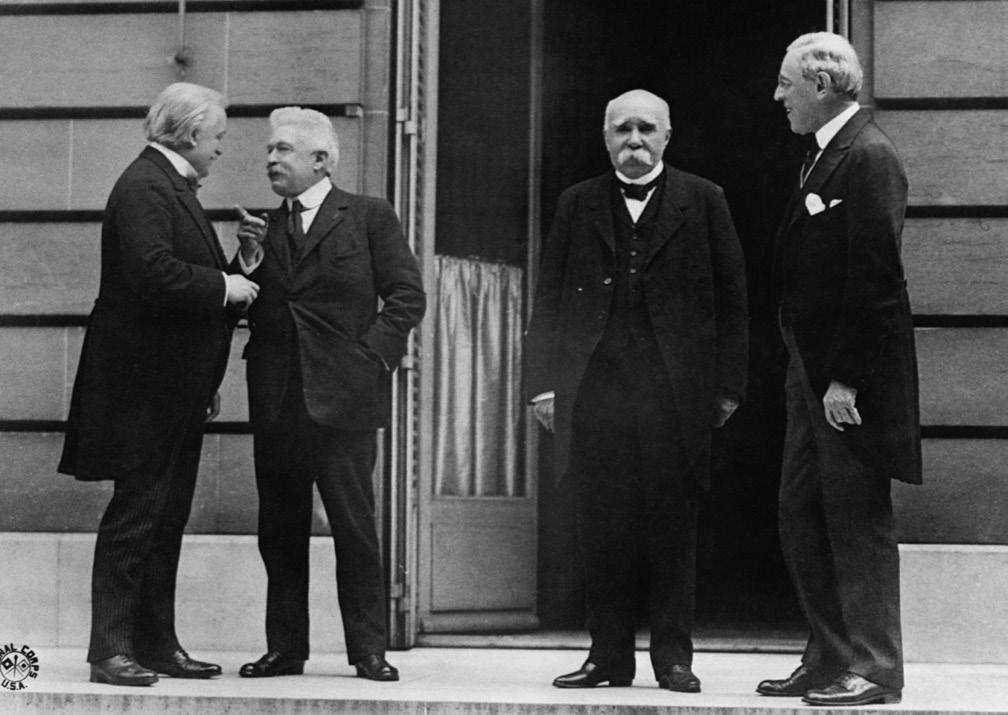
Key issues in agreeing the treaties
The peacemakers at Versailles faced a series of challenges. They had to end a world war, decide on the terms of the peace settlement and deal with the problems arising from the collapse of several major European empires.
The aims of the Big Three
Perhaps the most significant factor shaping the decisionmaking process was the disagreements between the USA, France and Britain over how the defeated Germany should be treated.
Wilson, representing the USA:
• wanted a more lenient peace, based on the Fourteen Points and his slogan ‘peace without victory’
• wanted to avoid causing resentment in Germany that might lead to war in future.
Wilson thought that the greed and selfishness of the rival European nations had been a major contributing factor to the outbreak of the First World War and saw himself as a mediator (go-between) between these nations. Wilson could not understand how anyone else could not accept his views and values. He felt that Germany was not solely responsible for causing this terrible war. However, Wilson had very little understanding of the complex problems facing Europe in 1919. Also, he could no longer claim to fully represent the government of the USA, as his political party, the Democratic Party, had lost control of the Senate in the elections of 1918. Under the US Constitution, the Senate had the right to reject any treaty the President made. The war had become increasingly unpopular in the USA. The Republican Party strongly opposed American involvement in the Paris peace talks as many Republicans believed that these were largely European matters and did not wish to be drawn in to any more European wars. By the time Wilson arrived in Paris, the Republican Party held a majority in the Senate. As Theodore Roosevelt, a former Republican president, pointed out: ‘Our allies and our enemies and Mr. Wilson himself should all understand that Mr. Wilson has no authority to speak for the American people at this time.’
Georges Clemenceau, representing France:
• wanted to destroy Germany economically and militarily
• wanted to avenge France’s humiliating defeat in the Franco-Prussian War of 1870–1871
• wanted the return of Alsace and Lorraine, regions of France taken by Germany in 1871
• wanted reparations (compensation) from Germany.
The USA had joined the war late, in 1917. As a result, the USA had suffered far less than its European allies during the war. In fact, the USA had greatly benefited from war economically and had lent large sums of money to the British to enable them to fund their war. Wilson firmly believed that imposing a harsh treaty on Germany would cause resentment and make future conflict more likely. He did not understand that the ideas in his Fourteen Points were not in line with opinions in Europe in 1918 and 1919. For example, the Fourteen Points had included the idea that nations should have the right to govern themselves. This idea had already been abandoned by the British and the French, as they had promised South Tyrol to Italy in 1915 and had agreed to give parts of the Turkish Empire to France in 1916.
Georges Clemenceau (1841–1929)
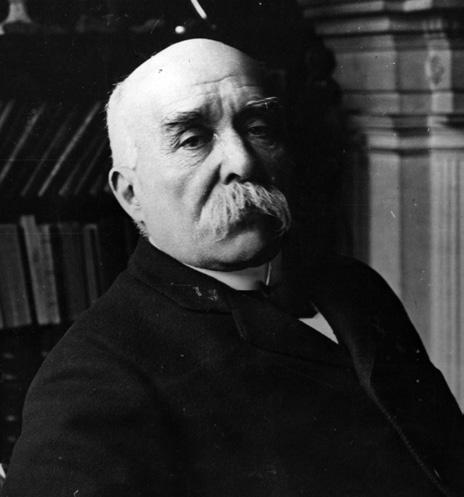
Clemenceau was a French politician who served as prime minister of France 1906–09 and 1917–20. In line with French public and political opinion, he insisted on a harsh settlement being imposed on Germany at the Paris Peace Conference.
Large areas of northern France had been destroyed in the bitter fighting since 1914. Nearly 2 million French soldiers and civilians had died in the war and millions more were permanently injured. When the German army retreated across France in 1918 they had deliberately destroyed everything which might be valuable, such as coal mines and canals. Paris had been shelled only months before the peacemakers sat down to make peace. Clemenceau wanted to ensure that Germany could never again threaten French borders. He was keen to secure a guarantee of British and American support in the event of any future German attack against France.
The domestic politics of the victorious powers also played an important part in the final terms. Clemenceau was an elected politician who had to respond to public opinion. French public opinion was not in sympathy with the ideals and principles present in Wilson’s Fourteen Points. The French people were demanding revenge for what they had suffered.
David Lloyd George, representing Britain:
• wanted a less severe settlement
• wanted to ensure that the German navy was no longer a threat to British domination of the seas or able to threaten Britain’s colonial interests in South or East Africa.
• believed that it was in British interests to allow Germany to recover quickly as Germany was a potentially important consumer of British exports.
David Lloyd George (1863–1945)
Lloyd George was the British prime minister from 1916 to 1922. He became a very powerful and charismatic wartime leader who played an important part in ensuring that Britain and France did not lose the war against Germany.
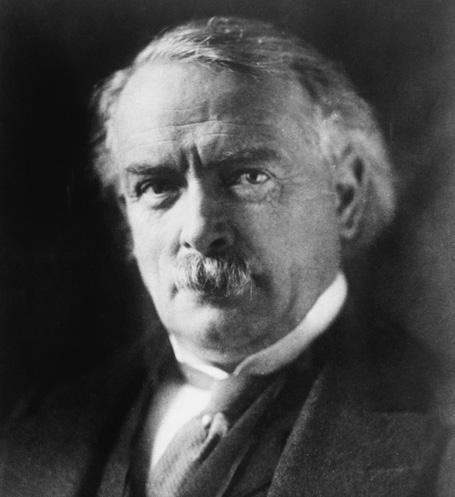
Like Clemenceau, Lloyd George was an elected politician. British public opinion was strongly anti-German, and Lloyd George had just won an election on the promise that he would ‘make Germany pay’.
However, Britain’s overseas trade needed to recover. Britain had been the world’s leading exporter in 1913 but, by 1919, it had been overtaken by both the USA and Japan. Also, the First World War had cost Britain over £3.25 billion (estimated). Britain desperately needed to increase its trade, and Germany provided a potentially valuable market for British exports. Also, there was less bitterness towards Germany in Britain than in France.
So, Britain sought a settlement that would punish Germany so that Germany did not threaten British interests – but one that would also make it possible for both Britain and Germany to recover economically in future.
Either on your own or in pairs, try to answer these questions. For each question, identify three key points which are important to your explanation. Place these points in order of importance. Suggest reasons why you have placed them in that order.
a Explain why the Treaty of Brest-Litovsk played a significant part in the final stages of the First World War.
b Explain why not allowing Germany to participate in the peacemaking was likely to be damaging to the outcome.
c Explain why the choice of Versailles, in France, was not a good choice of location for making the peace.
Lloyd George’s knowledge and understanding of European affairs was very limited, his experience as a minister before 1916 had been on domestic affairs. He had little awareness of the possible implications of some of his decisions for the peoples of central and eastern Europe. In addition, he often disagreed with the French on major issues. For example, he was personally
more sympathetic towards the Russian Revolution then the French were. France was owed a lot of money by Russia and Lenin was refusing to pay it back.
Representation of other powers
The peacemaking process was dominated by the ‘Big Three’, Wilson, Clemenceau and Lloyd George, but 32 nations were actually represented in Paris.
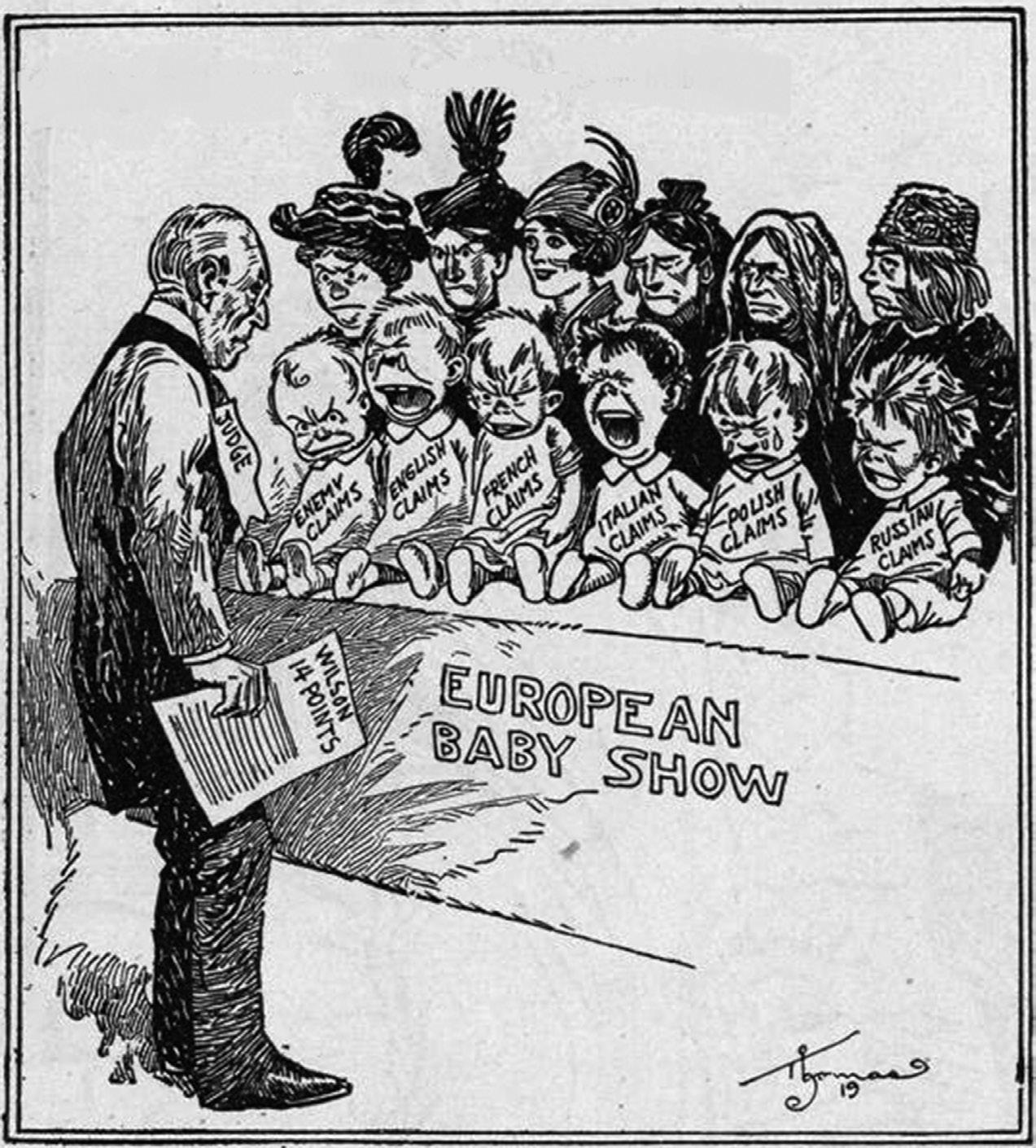
Discuss the following questions in pairs or small groups:
a Who is the main character depicted in the cartoon?
b What is the context of the cartoon?
c Why is the main character labelled as ‘judge’?
d Why are the European nations shown as babies?
e How accurate a picture of the peace settlement does the cartoonist portray?
Many were allies of the British, such as Australia, or countries such as Poland and Belgium that had suffered from Germany’s actions during the war. These countries played no real part in the outcome. Russia was not invited. It was in the middle of a civil war and the ‘Big Three’ were angry at Russia’s departure from the war against Germany in early 1918. The ‘Big Three’ also feared that a communist revolution would spread to other countries and refused to have any diplomatic relations with Russia’s Bolshevik government. Germany, Austria and Turkey, the defeated nations, were not allowed to have any role in the negotiations and were just informed of the terms that would be imposed on them.
Under these circumstances, it is perhaps unsurprising that the settlement that emerged from the Paris peace talks did not resemble Wilson’s vision of a ‘fair and just settlement’. Five separate treaties were agreed, each dealing with one of the First World War’s defeated nations. These were:
• the Treaty of Versailles with Germany
• the Treaty of Saint-Germain with Austria
• the Treaty of Neuilly with Bulgaria
• the Treaty of Sèvres with Turkey
• the Treaty of Trianon with Hungary.
All these nations had been German allies in the war.
The Germans hoped for a reasonable settlement based on Wilson’s Fourteen Points, which had been widely publicised in Germany. They were disappointed. The principal terms which affected Germany’s territory (land) were:
• Alsace and Lorraine were returned to France.
• Eupen and Malmédy went to Belgium.
• North Schleswig returned to Denmark. (Germany had taken it from Denmark in 1864.)
as compensation for the German destruction of French coal mines. After 15 years, a plebiscite would determine whether it should belong to France or Germany.
• The Rhineland, part of Germany along its border with France, would be demilitarised, meaning that no troops could be stationed there. This decision gave France the security that it wanted. It meant that Germany would be unable to defend this part of its border or use it as a starting point for invading France.
• The Saar Valley, a heavily industrialised region, would be administered by the new League of Nations for 15 years. During this period, France could take the coal from its coal mines
• Much of West Prussia went to Poland. Poland was given access to the sea through the ‘Polish Corridor’, which divided Germany from its province of East Prussia.
• The port of Memel (modern Klaipėda) went to Lithuania.
• Estonia, Latvia and Lithuania, which Germany had gained through the Treaty of Brest-Litovsk, were removed from German control and were established as independent states.
• Germany lost its African colonies, which became mandates under League of Nations supervision.
Plebiscite: A referendum (vote) in which local people express their opinion for or against a proposal relating to a constitutional issue.
Mandates: Overseas territories taken from the defeated countries at the end of the First World War. Responsibility for these territories was passed to other countries, which would administer them on behalf of the League of Nations.
For Germany, these territorial losses were both economically devastating and politically humiliating. The country was geographically split in two by the ‘Polish Corridor’, lost control of the major industrial region in the Saar and was forced to return the economically lucrative Alsace and Lorraine to France. Many German-speaking people moved from areas that now came under the control of other countries. Those who remained were often persecuted for Germany’s role in the war.
Northern Schleswig (to Denmark)
Danzig (free city under League of Nations control)
East Prussia
German losses to other countries
German losses to the League of Nations km 0100 0 100 miles
Areas retained by Germany after plebiscites
Demilitarised zone
German frontier after Treaty of Versailles
The Treaty of Versailles contained further terms, including the following:
• The German army was limited to a maximum of 100 000 troops and was not allowed tanks or military aircraft. The navy was allowed no submarines and a maximum of six battleships. These restrictions were intended to weaken Germany’s armed forces so much that it could not pose a threat to other European countries in the future. The restrictions were deeply humiliating for a nation with a proud military tradition.
• Anschluss (union) between Germany and Austria was forbidden. This term aimed to prevent the two German-speaking countries uniting and forming a powerful nation in central Europe.
• The ‘War Guilt Clause’ blamed Germany and its allies for the outbreak of the First World War. The Germans had to accept that Germany alone was guilty of causing the war. The victorious nations imposed reparations on Germany for the damage the war had caused, and the War Guilt Clause provided legal justification for making Germany pay these reparations. Imposing reparations on Germany was also intended to weaken the country economically so that it could not threaten other countries in the future.
The treaties of Saint-Germain, Neuilly, Trianon and Sèvres
Having finalised the Treaty of Versailles with Germany, the Paris Peace Conference now turned its attention to
the other defeated nations (Austria-Hungary, Bulgaria and Turkey). In many ways, Wilson’s notion of giving independence and self-determination to the peoples who formerly belonged to the Habsburg, Turkish and Russian empires was becoming a reality. The disintegration of those empires had already resulted in the emergence of new states. The Paris peacemakers had the difficult task of trying to formalise the resulting chaos. Their decisions formally confirmed the existence of new national states: of these, the main new states were Yugoslavia, Poland, Czechoslovakia, Austria and Hungary. These states became known as the successor states. Again the ‘losers’ were not allowed to negotiate and were just presented with the terms.
Self-determination: The principle that people of common nationality should have the right to form their own nations and govern themselves.
Successor states: Newly formed states whose territory and population were previously under the sovereignty of another state.
Each of the defeated nations was dealt with separately through a series of four treaties.
• The Treaty of Saint-Germain was signed with Austria in September 1919. By the terms of this treaty, Austria lost territory to Czechoslovakia, Yugoslavia, Romania, Poland and Italy. The formerly great Austro-Hungarian Empire, which had dominated central and eastern Europe and the Balkans since the 16th century, came to a humiliating end.
• The Treaty of Neuilly was agreed with Bulgaria, which had been a German ally in the war, in November 1919. Bulgaria lost territory to Greece, Yugoslavia and Romania. It had to reduce its army to no more than 20 000 and was instructed to pay reparations of over $400 million.
• The Treaty of Trianon with Hungary (June 1920) stated that Slovakia and Ruthenia were to become part of Czechoslovakia. Hungary also lost Transylvania to Romania, and Croatia and Slovenia to Yugoslavia.
• Under the terms of the Treaty of Sèvres, signed in August 1920, Turkey lost territory to Greece and Italy. Other parts of the former Turkish Empire
were given as mandates: Syria was given to France, and Palestine, Iran and Transjordan were given to Britain (see Figure 2.6). The treaty also stated that the Dardanelles were to be permanently open to all shipping. The Turkish National Movement was established, led by Mustafa Kemal later known as Atatürk. It aimed to overturn the terms of the Treaty of Sèvres and expel foreign soldiers from the country. By October 1923, both these things had happened, and the new Republic of Turkey was proclaimed, with Atatürk as its first president.
All the treaties were to create new problems. Redrawing the map of Europe, satisfying the demands of the victors and managing the collapse of empires came at a cost. For example 1.6 million people who considered themselves Hungarian would now be living under a foreign government in Romania. Many who saw themselves as Germans found themselves in the new state of Czechoslovakia. Also, many of the newly created boundaries would make it impossible for some countries, such as Austria and Hungary, to be able to survive economically.
There was the expectation that the new nations would become liberal democracies, like Britain and France, but this transition to a new form of government could be difficult in countries like Poland and Yugoslavia where there was no tradition of democracy or popular elections. Creating a government which was acceptable to the majority of the population was a challenge. Some of the new nations such as Czechoslovakia faced the difficulty of having no common language, which led to communication difficulties. What should be the ‘official’ language? Some even had different railway systems which would have to be coordinated.
Liberal democracy: Where a government is elected and implements liberal principles such as the rule of law, protection for individual rights and liberties and freedom of speech.
In Hungary a radical communist dictator, Béla Kun, seized power in 1919, murdering all his opponents and invading Czechoslovakia and Romania in order to gain more territory for his new nation. Another major challenge came in 1920 when Poland attempted to invade the Ukraine and seize territory there but was driven out by the Russians. The range of difficulties was enormous.
None of the representatives of the Big Three at Versailles had much knowledge or understanding of the complexities involved in creating boundaries, and these complexities were not important to their voters. Wilson’s Fourteen Points had offered some suggestions about what might happen to the area. For example:
• Poland should be given ‘secure access to the sea’.
• The peoples of the former Austro-Hungarian Empire should be given every opportunity for ‘autonomous development’, or the right of a people to develop in their own way.
These had seemed sensible at the time, but many problems arose when actually trying to put these ideas into practice.
In redrawing the map of Eastern Europe, the peacemakers had left around 30 million people living in minority groups under foreign rule. This situation made border disputes inevitable as many reluctant members of these new nations wanted boundaries to be redrawn so they could be part of their ‘own’ nation. Examples of difficulties created by the new boundaries are as follows:
• Yugoslavia was formally established in December 1918. Yugoslavia was made up of the previously independent kingdoms of Serbia and Montenegro, together with territory that had been part of the old Austro-Hungarian Empire. It now became home to people of varying ethnic and religious backgrounds – Serbs, Croats, Bosnians, Slovenes, Magyars, Germans, Albanians, Romanians and Macedonians, Orthodox and Roman Catholic Christians, Jews and Muslims. In some cases these groups had got on well together. However, in other cases there had been long-term rivalries and bitter conflict and these tensions led to great resentment when these groups were included in the same nation.
Ethnic: Relating to a group of people who share a common history and culture.
• The contested boundaries between Italy and Austria should be drawn ‘along clearly recognisable lines of nationality’.
• The territories in the Middle East which had been part of the Turkish Empire should also be given the ‘opportunity for autonomous development’.
• Poland had been controlled for more than a century by foreign powers, such as Germany and Austria and most recently Russia. In November 1918, Poland re-emerged as an independent nation with new boundaries. Of Poland’s population of 27 million, fewer than 18 million were Poles and more than 1 million were German who did not want to be Poles. Wilson’s promise to give Poland access to the sea meant that East Prussia was cut off from the rest of Germany. This situation infuriated the Germans, who wanted a different boundary.
• Czechoslovakia emerged from the collapse of the Austrian Empire in October 1918, and its existence as an independent state was confirmed by the Paris peace settlement. In addition to Czechs and Slovaks, Czechoslovakia now
contained former Russians, Hungarians, Poles, Jews and more than 3 million German speakers. The German-speaking populations of Bohemia, Moravia and the Sudetenland made up a sizeable minority group that persistently claimed it was being discriminated against.
• Austria was landlocked and most of its industrial areas were given to Poland and Czechoslovakia by the Treaty of Saint-Germain. This redistribution of territory caused enormous economic problems for Austria. Its new boundaries made Austria economically unviable and dependent on foreign loans to survive.
Unviable: Unlikely to work; having no chance of success. (Something that can work is known as ‘viable’.)
Inconsistent application of national self-determination
Maintaining a commitment to self-determination was not as straightforward as Wilson had hoped. Wilson had believed that nationality could be determined by language, but this idea was too simplistic for the complicated situation in Eastern Europe, where there were so many ethnic groupings, all with conflicting ambitions. Because so many people in Eastern Europe were left living as minority groups in foreign countries, many people naturally felt that self-determination applied only to the victors.
Many historians are critical of the Paris peace settlement of 1919–1920, which had both short- and long-term effects on international stability. They argue that the five treaties were based on a series of compromises that satisfied none of the countries involved. Representatives of the victorious nations drew up the peace terms, while the defeated nations had to accept the terms imposed upon them. In addition, it was not only the defeated nations that were frustrated and angry at the peace settlement. France, Russia, Italy and the USA, countries that had played a significant role in the Allied powers’ victory, were also disappointed.
The victors: France, Britain, the USA, Italy and Japan
Amongst the victorious powers there was little satisfaction with the peace settlements and often bitter disappointment.
Generally, French public opinion was disappointed that France’s huge sacrifice had produced so little return. However, people also felt enormous relief that the killing was over and were willing to try to make the peace work. The return of the provinces of Alsace and Lorraine, which had been taken by Germany in 1871, was important to France as these provinces contained valuable resources.
While it was not difficult to apply the principle of self-determination to Estonia, Latvia and Lithuania, it was much more difficult in the case of Germany. The need to make Czechoslovakia a viable nation meant that it was given the largely German-speaking and strategically and industrially important area known as the Sudetenland. The loss of the Sudetenland angered the Germans. The Germans in the Polish Corridor felt that the principle of self-determination did not apply to them as they were on the losing side. The area which became Yugoslavia was made up of so many different nationalities and racial groups that the only way to create a nation that might be in any way viable was to ignore the principle totally.
However, France had wanted and expected a much harsher settlement imposed on Germany. Indeed, Clemenceau had argued for the creation of an independent Rhineland state and proposed that Germany should be broken up to permanently weaken it. France feared that the settlement left Germany strong enough, both economically and politically, to threaten the security of France again. This fear dominated French foreign policy throughout the 1920s.
Most important to the French people was the payment of reparations. Germany had imposed reparations on France after France’s defeat in 1871. The First World War had devastated large parts of northern France, including French industry there, and the French people wanted compensation. Ultimately, they were disappointed that this wish was unfulfilled.
Britain’s reaction was mixed. The British did not feel the passionate desire for revenge that existed in France. Some people felt strongly that the peace terms were too harsh, especially the reparations demanded from Germany, and that these terms might lead to further disputes. The idea of a League of Nations to prevent a repeat of the war was very popular, and the demand by some politicians during an election in 1918 to ‘Hang the Kaiser’ did not arouse much interest. The slogan ‘Homes fit for Heroes’ aroused much more interest, by promising to provide decent homes for returning soldiers.
The military were pleased that the German navy was no longer a threat, and British trade routes were secure. Most of the former German colonies in Africa came under British control – however, these colonies were of little commercial value, and getting responsibility for parts of the former Turkish Empire in the Middle East actually added to Britain’s problems.
The overall reaction was of huge relief that the war was finally over. Later, however, Britain realised that its economy had suffered great damage during the war. This damage was largely responsible for a major depression.
The Fourteen Points were both contradictory and imprecise. Trying to apply them to specific situations in Europe was bound to lead to the peacemakers being attacked for violating [breaking] them in some respect. The Treaty, however, represents a breach of faith with a defeated and broken enemy who had laid down their arms on the assurance of a Wilsonian peace. The terms of Versailles are unnecessarily harsh over the Saar and the Polish corridor – and the cruellest part of it all is the Anschluss. The Treaty is a French peace – a Clemenceau peace.
From an open letter to the British government by the Leaders of the League of Nations Union in Britain, May 1919.
b How accurate was the comment that, ‘The Treaty was a breach of faith with a defeated and a broken enemy who had laid down their arms on the assurance of a Wilsonian peace’?
c Why could the comments about the Saar, the Corridor and the Anschluss be seen as unfair criticism of the Treaty?
d How justified is the comment that the Treaty was a ‘French peace – a Clemenceau peace’?
The US President Woodrow Wilson had played a leading role in determining the terms of the Paris peace settlement and made strenuous efforts to convince the American people to support them. However, public opinion in the USA was largely opposed to the settlement. Many Americans believed that its terms were too harsh on Germany and that this situation would cause resentment and encourage the desire for revenge. Most argued that to support the settlement and, in particular, to join the League of Nations, would inevitably involve the USA in future wars. The US Senate, dominated by Wilson’s Republican political opponents and anxious to damage Wilson, refused to ratify the peace settlement, and the USA subsequently signed its own separate treaty with Germany. The Americans had played a vital role in the drafting of the actual Treaty of Versailles, but they never actually signed it.
Ratify: To give formal acceptance to something. For example, the diplomats negotiating at a conference can agree the terms of a treaty, but they do not come into effect until they have been formally accepted (ratified) by their government.
Read the extract from the letter carefully, and then either on your own, or in pairs, consider the following questions.
a How accurate was the view on the Fourteen Points?
Italy pre-1914
Territory promised under 1915 Treaty of London
Territory actually ceded to Italy 1919–20
Disputed City of Fiume (ceded to Italy, 1924)
Territory occupied by Italy, 1914–20
Despite its membership of an alliance with Germany and Austria-Hungary before the war, Italy did not enter the First World War when it began in 1914. However, in April 1915 Italy signed the Treaty of London with Britain, France and Russia in return for promises of major territorial gains along the Adriatic coast, which would be taken from the Austro-Hungarian Empire after victory was achieved. The Italians also trusted in a vague promise that Italy would get a share of the reparations paid to the Allied powers by Germany.
Italy thus joined the war on the side of Britain, France and Russia. Italy’s involvement in the war was not very significant militarily, but it was expensive for the Italians in both human and financial terms. Over 600 000 Italian soldiers were killed and 950 000 seriously wounded. The Italian government spent more money in the three years of war than it had in the previous 50 years. Once the war was won, the Italian people expected the promises made in the Treaty of London to be honoured.
To most Italians, the Paris peace settlement was a bitter disappointment. The major decisions had been taken by the ‘Big Three’, Wilson, Clemenceau and Lloyd George. The Italian delegation, led by Prime Minister Orlando, had been largely ignored and humiliated. Although Italy had gained Trentino, South Tyrol, Istria and Trieste, its claims to parts of Dalmatia, Albania, Fiume, Adalia (Antalya on the south Turkish coast) and some of the Aegean islands had been denied.
The Italians felt that other countries, especially Yugoslavia, had gained at Italy’s expense. In addition, when the other victorious powers decided to postpone discussion about the details of German reparations until 1922, the Italians assumed (correctly) that they would get nothing, and this caused great anger. Although Italy had been on the winning side, it had reason to feel unhappy with the peace treaties. That unhappiness caused later major problems for international peace.
b Do you think Italy was justified in feeling disappointed? Why? Do you think Italy was treated fairly?
Japan
Japan had entered the war in 1914 on the side of France and Britain. Japan played little part in the detailed negotiations at Versailles in terms of Europe and the Middle East. However, Japan did gain substantially from the overall treaties. Japan saw its presence at Versailles as important, because it demonstrated its status as a ‘Great Power’ alongside the USA and France. In addition, Japan gained control of the former German colonies in China, and international acceptance of its growing presence in Manchuria. (Figure 3.8 shows how Japan’s presence in Manchuria had grown by 1931).
Japan had good reason to be pleased with the peace treaties because it had achieved its expansionist ambitions in China. However, Wilson did not agree to Japan’s request for a racial equality clause in the League of Nations Covenant (the terms that the League members agreed to). This clause would have guaranteed equal treatment for people of all races. Many of Wilson’s political supporters in the southern states of America, which had formerly allowed the ‘owning’ of enslaved people, would not have accepted such a clause. The refusal to include a racial equality clause caused anger and resentment in Japan and damaged its relationship with the USA for years.
For the First World War’s defeated nations, the implications of the peace settlement could be seriously damaging. Bulgaria was much reduced in size and the Bulgarian economy was severely damaged by the terms of the Treaty of Neuilly. Turkey no longer controlled its once great empire and remained under the authority of an Allied army of occupation. It also felt humiliated.
Either on your own or in a pair, consider the following question, ‘Explain why Italy was disappointed by the outcomes of the peace settlements in 1919.’
a Identify at least three reasons for Italy’s disappointment, and then analyse which you think was the most important, and why.
Austrians and Hungarians also were angry at the way in which the Paris peace settlement had divided up the territories of the former Austrian-Hungarian Empire among newly formed nation states. They argued that the First World War’s victorious nations had created new boundaries without considering cultural, language-related and ethnic factors. The Austrians and Hungarians had requested that plebiscites should be held to find out the wishes of local people, but these requests had been ignored.
The refusal to hold plebiscites added to the sense that only friends of the victors would enjoy self-determination.
Germany had not been allowed to participate in the peace negotiations. Its representatives were members of the new German government. These representatives were still expecting a peace settlement based on the Fourteen Points of January 1918, unaware that France and Britain had not supported the Fourteen Points. Germany also expected to keep the territory that it had gained through the Treaty of Brest-Litovsk. When the German representatives were informed of the terms of the peace settlement, they were horrified.
There is arguably some justification for the German objections:
• At a time of intense political instability, 100 000 troops (the number allowed) might not be enough even to maintain law and order within Germany itself, and would fail to defend the country against external attack. Also, while Germany was forced to disarm (give up its weapons), it was clear that no other major European powers intended to do so – this difference in treatment meant a threat to German security. Germany had a strong military tradition and did not like seeing it destroyed.
• Although they were set up as mandates under the supervision of the League of Nations, Germany’s former colonies in Africa were effectively taken over by Britain, France and South Africa. The reallocation of colonies seemed like more prizes to the victors.
• Millions of people who were German in terms of their language and culture now lived under foreign rule in countries such as Poland and Czechoslovakia.
• Although East Prussia was part of Germany, it was separated from the rest of the country by the Polish Corridor.
• The War Guilt Clause caused particular resentment in Germany because of the complicated series of events that had led to the outbreak of war in 1914. The Germans felt that other nations should share some part of the blame.
However, many historians have argued that, because they had ignored Wilson’s Fourteen Points when inflicting the Treaty of Brest-Litovsk on Russia, Germany had little right to expect those points to form the basis of their own peace settlement. In fact, in Europe Germany lost only territory that it had gained as a result of previous wars and remained potentially the strongest economic power in Europe.
• The amount established for reparations was extremely high and virtually impossible for Germany to pay.
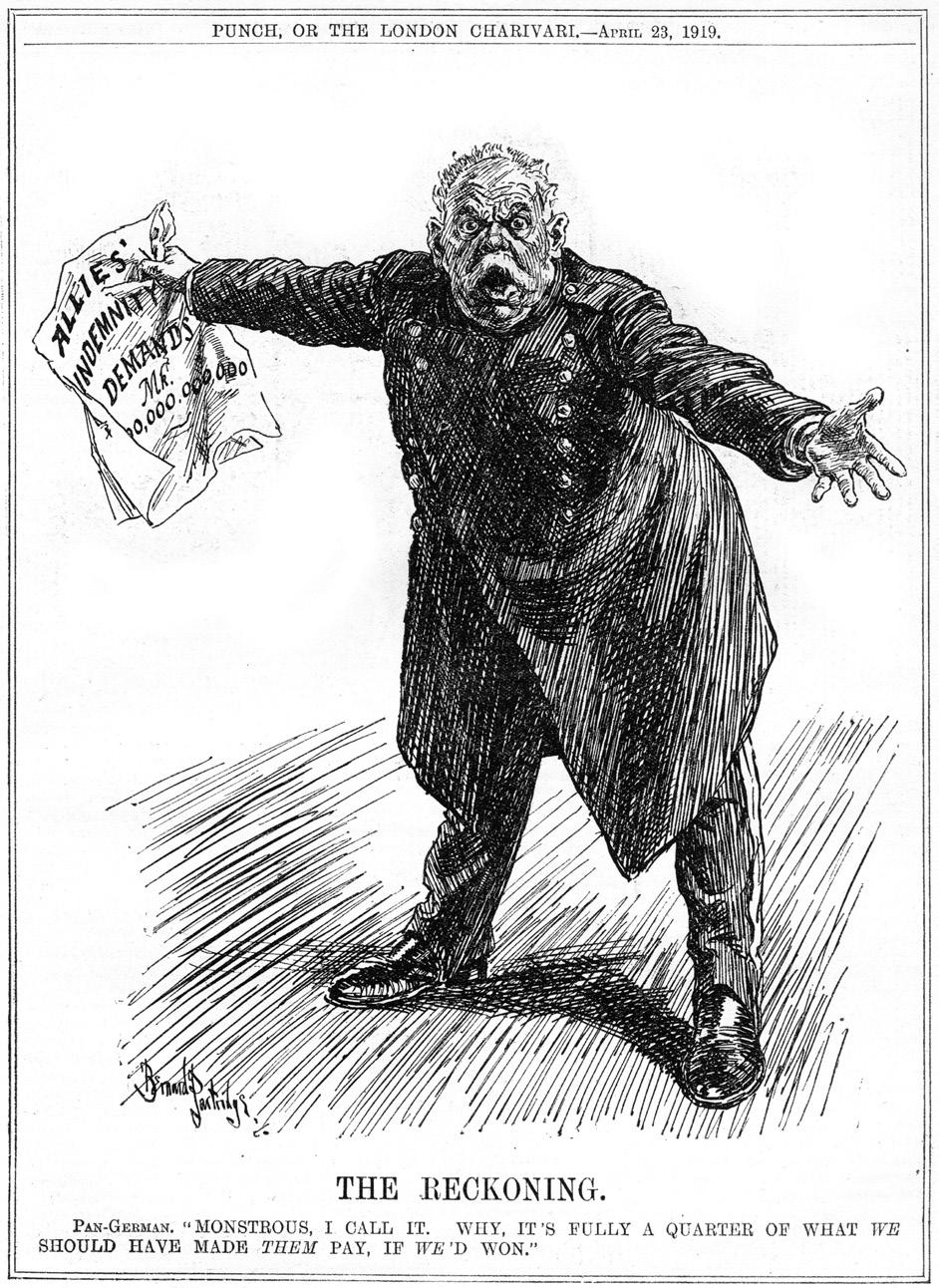
Figure 2.9: A cartoon titled ‘The Reckoning’, published in a British magazine in 1919. The newspaper the figure is holding is headed ‘Allies’ indemnity demands’. The text at the bottom says, ‘PanGerman. “Monstrous, I call it. Why, it’s fully a quarter of what we should have made them pay, if we’d won.”
Look at the cartoon in Figure 2.9.
a What point is the cartoonist making?
b How valid do you think the point is?
c To what extent can the cartoon be seen as showing anti-German bias?
The terms of the Treaty of Versailles caused great resentment in Germany. Nevertheless, Germany had to accept the treaty – failure to do so would have meant the continuation of war and an attack on Germany itself. The German people were starving, and many were dying in a flu pandemic. There were battles on German streets between former soldiers and communists. The Germans were in no position to renew fighting. The German representatives signed the Treaty of Versailles on 28 June 1919 because they felt that they had no alternative. In doing so they accepted the loss of some 70 000 square kilometres (27 000 square miles) of former German territory, containing some 7 million people.
The army had ultimately been responsible for Germany’s defeat in the war. However, the army commanders were able to convince many in Germany that defeat was not their fault and that they had been ‘stabbed in the back’ by the new civilian government after the Kaiser had abdicated. German resentment against the Treaty of Versailles, and the idea of the ‘stab in the back’ against the German military, had major implications for the future.
President Wilson had called for a ‘peace without victory’.
a In pairs, discuss the reasons why the First World War’s defeated nations would have been disappointed and angry about the outcomes of the Paris Peace Conference.
b What do you think were the possible implications of their disappointment and anger?
c Make out a case both for and against imposing the terms that were imposed on Germany and its allies.
not forget that the countries that wrote the Treaty of Versailles also sent their troops to Russia in 1919 to try to stamp out the communist revolution.
Involved in the bitter civil war in Russia, Lenin took little interest in events in Versailles. In 1919 he set up the Communist International, an organisation that aimed to spread revolution throughout Europe and the world. Lenin’s action gave a clear indication of his intentions and his attitude towards the other powers.
The peace settlements created many controversies. However, two issues caused the most debate and anger: the question of ‘war guilt’ and the requirement for Germany to pay reparations. These two issues possibly had greater implications for the future than any other issue.
Perhaps one of the most controversial parts of the whole Versailles settlement was what became known as the ‘War Guilt Clause’. The clause was set out as Article (clause) 231 of the treaty.
Article 231 of the Treaty of Versailles stated:
The Allied and Associated Governments affirm, and Germany accepts the responsibility of Germany and her allies for causing all the loss and damage to which the Allied and Associated Governments and their nationals have been subjected as a consequence of the war imposed upon them by the aggression of Germany and her allies.
Russia was not invited to send representatives to the peace conference and was not consulted at all about the terms of the settlement. This exclusion from international affairs left Russia feeling increasingly isolated and angry, with much of its former territory in Eastern Europe divided up amongst newly created nations, including the Baltic states of Lithuania and Estonia. Lenin’s new communist government did
In signing the Treaty of Versailles, Germany accepted its own responsibility, and that of its allies, for causing the First World War and for paying for the damage it had caused to the victors.
Considering the tensions that had built up in Europe during the late 19th and early 20th centuries, and the complicated events that led to war in 1914, it may seem unreasonable that the victorious nations expected Germany and its allies to accept full responsibility for the war. The Germans certainly thought so. However, including the War Guilt Clause in the Treaty of Versailles provided legal justification for expecting Germany and its allies to pay reparations.
Germany’s enemies had suffered greatly during the First World War, both economically and in human terms. France, in particular, demanded compensation. France had suffered most during the war. Many of the war’s major battles had taken place on French soil – whole towns and villages were destroyed, and France’s main industrial region in the north had been devastated. Reparations would enable reconstruction, both in France and in other countries such as Belgium which had been badly affected by the war.
The issue of reparations caused disagreement among the ‘Big Three’ at Versailles. Wilson was entirely opposed to inflicting reparations on the defeated nations, arguing that doing this would cause resentment and instil in Germany a desire for revenge. This situation had happened with Germany and France in 1871 – but the French had paid reparations then. Also, Germany had taken productive territories such as the Ukraine from Russia in 1918 as compensation. Clemenceau, therefore, believed that the Germans should now pay high reparations in their turn. In addition to providing compensation for war damage, Clemenceau viewed reparations as a way of keeping Germany weak so that it could never threaten France again. Lloyd George agreed with the principle of reparations but wanted to keep them as low as possible so that the German economy could recover quickly and reestablish its trading links with Britain.
After long debates, the Paris Peace Conference finally agreed to impose reparations on Germany and the other defeated nations. The task of setting the amount that each country would have to pay was given to a Reparations Commission that would meet in 1921. However, it was already clear that most of the reparations requirements would be imposed on Germany and Bulgaria. The treaties of Saint-Germain, Trianon and Sèvres recognised that Austria, Hungary and Turkey had very limited resources and would find it difficult to pay reparations.
As a result, the heaviest burden in terms of reparation payments fell on Germany, which was instructed to pay a total of £6.6 billion. The German representatives at meetings of the Reparations Commission were horrified. They argued that Germany was in no position to meet such demands, as the war had devastated its economy.
When the Reparations Commission met in 1921 it considered the resources available to each of the defeated nations and listened to the views of their representatives before deciding how much each country should pay. Because of the major economic problems facing Austria and Hungary, no reparations were imposed on them. Limited reparations were imposed on Turkey, but these were eliminated under the terms of the Treaty of Lausanne in 1923. A figure of £100 million was set for Bulgarian reparations but only a small amount of this had been paid by 1932 when the requirement was abandoned.
The German representatives were not alone in criticising such a high reparations demand. The British economist John Maynard Keynes, who had attended the Paris Peace Conference, argued that reparations at such a high level would add to the economic problems facing post-war Europe. In particular, he argued that reparations would lead to high inflation. However, Clemenceau’s demands for reparations won. Keynes’s prediction that German reparations would cause economic problems in Europe was accurate. Similarly, President Wilson’s fears that imposing reparations on Germany would lead to resentment and the desire for revenge turned out to be correct.
John Maynard Keynes (1883–1946)
Keynes was the leading economist of the early 20th century and was a member of the British delegation at the Paris Peace Conference. In his book The Economic Consequences of the Peace (1919), he argued that reparations were vindictive and would lead to problems because Germany would be unable to keep up with the payments.
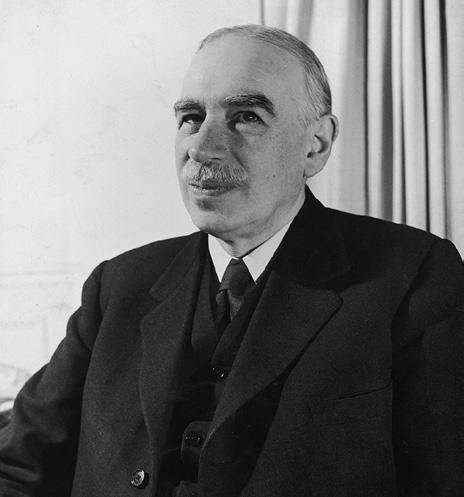
Inflation: A process that leads to an increase in the price of goods and services. It drives down the value of income and savings, discouraging investment and causing demands for increased wages. This loss of value in turn leads to higher prices, an inflationary spiral that can result in increased unemployment.
The Treaty includes no provisions for the economic rehabilitation of Europe–nothing to make the defeated Central Empires into good neighbours, nothing to stabilise the new states of Europe, nothing to reclaim Russia. It is an extraordinary fact that the fundamental economic problems of a Europe starving and disintegrating before their eyes, was the one question in which it was impossible to arouse the interest of the Four. Reparation was their main excursion into the economic field, and they settled it without considering the economic future of the states whose destiny they were handling. Clemenceau was preoccupied with crushing the economic life of his enemy.
From J. M. Keynes, The Economic Consequences of the Peace, 1919.
a What was the main reason for Keynes’ objection to reparations?
b To what extent do you think this was unfair criticism of the ‘Big Three’?
Work in two groups. Imagine you are at a meeting of the Reparations Commission. One group should represent France; the other group should represent Germany.
a The ‘French’ group should make out a case explaining why the reparations expected from Germany are fully justified.
b The ‘German’ group should explain why reparations are both unjustified and likely to be harmful to future international relations.
c Each group should present its case to the class.
How did you decide which case was the stronger? What criteria did you use to base your conclusion on? Think about any difficulties that you faced in trying to weigh up the two arguments? How did you ensure that you reached a balanced judgement?
d Now, as a class, evaluate the two arguments. In the context of 1919, who do you feel had the stronger case? (Alternatively, you could do this activity in pairs.)
Considering the disappointment of the First World War’s victorious nations, the resentment of those that had been defeated and the problems faced by the ‘successor states’, it is easy to see why many historians are critical of the Paris peace settlement. However, such criticisms do not fully consider the difficult circumstances that faced the men responsible for drawing up the settlement. Satisfying the competing demands of the victorious nations was almost impossible. In Eastern Europe, the peacemakers had to recognise situations that had already emerged following the disintegration of the Habsburg, Turkish and Russian empires towards the end of the war. In fact, far fewer people were living under foreign rule in 1920 than had been the case in 1914. As an American delegate at the peace talks claimed: ‘it is not surprising that they made a bad peace: what is surprising is that they managed to make peace at all.’
Many people in Germany and in other countries felt that the Treaty of Versailles was not ‘fair’ on Germany, and that it was not a ‘just’ treaty either. Those two words, ‘fair’ and ‘just’ often appear in essay questions about the Versailles Treaty. Work out carefully what you think a ‘fair’ and a ‘just’ treaty would be in the context of 1919 (the two words can mean quite different things!). Get a clear definition in your mind of those words. Then draw up a plan for each of the following essays. Make sure that you set out a clear case ‘for’ and ‘against’ each statement, indicating the main points you would make. (Plan your argument–don’t just list facts!)
a ‘Versailles was a fair treaty as far as Germany was concerned’. How far do you agree?
b ‘Germany was unjustly treated by the Treaty of Versailles.’ How far do you agree?
Working in a group, allocate the role of a defence and a prosecution lawyer for each of the ‘Big Three’ over their roles in the making of the Peace Settlement.
a Which of the two roles in each case would you find most challenging? Why?
b Which of the two roles in each case would you find the easiest? Why?
c If you are the defence lawyer for your allocated country:
i Identify the three main points you would use in the defence.
The Treaty of Versailles has generated much debate among both people who were involved at the time and later historians.
The settlement of 1919 was an immense advance on any similar settlement made in Europe in the past. In broad outline it represents a peace of reason and justice and the whole fabric of the continent of Europe depends on its maintenance.
From Diplomatic History by James Headlam-Morley, a British historian involved in the drafting of the Versailles Treaty, 1927.
The Treaty includes no provisions for the economic rehabilitation of Europe–nothing to make the defeated Central Empires into good neighbours, nothing to stabilise the new states of Europe, nothing to reclaim Russia . . . It does not promote any economic solidarity amongst the Allies themselves. There is no arrangement for restoring the disordered finances of Europe, or to adjust the systems of the Old World and the New. It is a disaster.
ii Identify the three points which you think the prosecution would focus on. How would you counteract them?
From The Economic Consequences of the Peace by the economist J. M. Keynes, who was involved in the peace negotiations at Versailles, 1919.
d If you are the prosecuting lawyer for your allocated country:
i Identify the three main points you would use in the prosecution.
ii Identify the three main points which you think the defence would focus on. How you would counteract them?
The Versailles Treaty was not exceptionally harsh considering how thoroughly Germany had lost a long and bitter war.
From Sally Marks, The Illusion of Peace, 1976.
The Versailles Treaty of 1919 was one of the most outrageous treaties in history. It was an act of plunder perpetrated by a gang of robbers against a helpless, prostrate and bleeding Germany. Amongst its provisions, it required Germany and its allies to accept full responsibility for causing the war, disarm and make substantial territorial concessions.
From an article ‘The Treaty of Versailles, the Peace to end all Peace’, by Alan Woods, 2009.
Look back at the information in this section. Work with a partner and analyse why these British historians, two of whom were involved in the Treaty of Versailles, and two writing decades later, have come to such different conclusions about the treaty. Why do you think that historians, even after many years of research, looking at the same facts, still disagree? Which interpretation do you think is correct? Why?
Read the sources and then answer both parts of the question.
I have always been a sincere advocate of an agreement between the leading nations to set up the necessary international machinery that would bring about a practical abolition of war. But it is inadvisable to join a League of Nations that would make it necessary for the USA to maintain a standing army. This would be needed to support new and independent governments that it is intended to establish among semi-civilized people. This could involve the USA in wars in Europe, Asia and elsewhere. Rather, we should disarm the defeated nations and then follow the example by disarming ourselves. If the world is disarmed there will be no more world wars. Nations should be left entirely independent to decide their own affairs.
From a letter written by Senator George Norris (Republican) to an American newspaper, the Nebraska State Journal, 18 March 1918.
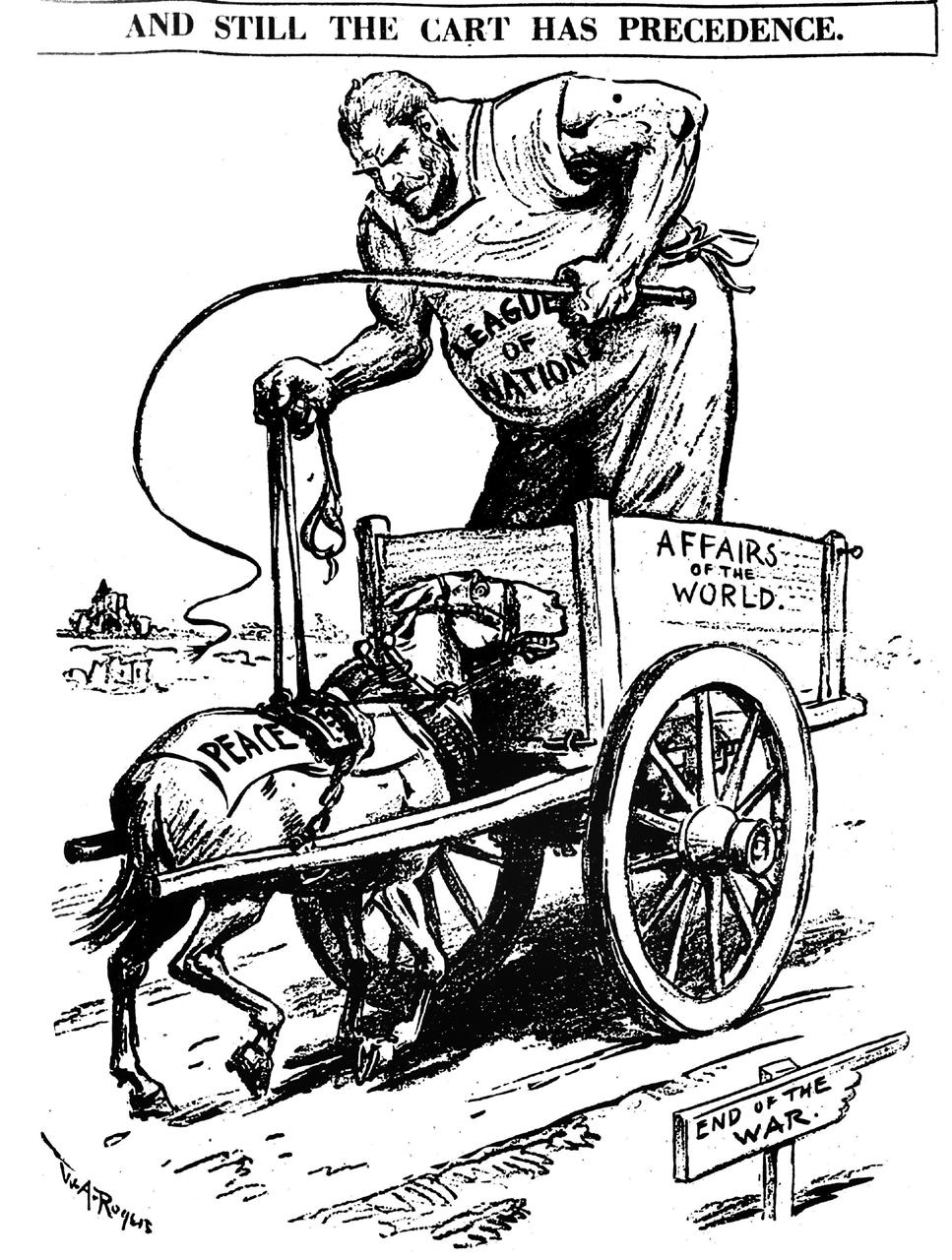
An American cartoon, published in 1919, commenting on the implications of joining League of Nations.
The Republicans are trying to defeat the plan for a League of Nations, which, if organised, will reduce military armament among all the great powers, and make war almost, if not, completely impossible. If the Senate destroys the League of Nations, then the USA must begin at once to arm on a greater scale than any other nation in the world, because we must be strong enough to beat all comers. This means a navy in the Atlantic big enough to overcome the combined navies of at least three European powers. It means a navy in the Pacific bigger than Japan. It means the greatest standing army we have ever had. If we want to promote human slaughter and increase taxation, we should defeat the League of Nations. If we must abandon the glorious ideas of peace for which this nation has always stood, we must do so with full knowledge that the alternative is wholesale preparation for war.
From a public speech by Senator William G. McAdoo (Democrat), 1919.
I am in favour of the League of Nations Covenant, of which our gallant and noble President is the proposer. I believe Mr. Wilson will be able to accomplish the fulfilment of the Covenant despite all opposition. The League of Nations idea is a very delicate matter to handle, and no-one but our President, who possesses the necessary qualities, could really be at the head of it. The abuse and discredit given to our President by the Republicans would make one imagine that these men lack intelligence. They know the Covenant is good for humanity; they should boost the League instead of criticising it. Their criticism of every move President Wilson makes implies that they are foolish or influenced by political motives. The League of Nations will alleviate all
unrest, discontent and anxiety, and will make the world safe for democracy. The League would promote commerce, civilisation and brotherly love. I sincerely hope our President sees his way clear, and happy will I be the day the Covenant is accomplished and put into operation.
From a letter to an American newspaper, the Evening Public Ledger (Philadelphia), 28 March 1919.
1 a Read Sources A and B
Compare the views of Senators Norris and McAdoo on whether the USA should become a member of the League of Nations. [15 marks]
b Read all of the sources.
To what extent do Sources A to D support the view that the League of Nations would be more likely to cause wars than prevent them? [25 marks]
Essay-based questions
Answer both questions. Answer both parts of each question.
2 a Explain why the Dawes Plan was developed in 1924. [10 marks]
b ‘The Locarno Treaties of 1925 greatly reduced tension between European nations.’ How far do you agree? [20 marks]
3 a Explain why France occupied the Ruhr region of Germany in 1923. [10 marks]
b ‘The structure of the League was the main reason for its weakness’. How far do you agree? [20 marks]
1 b To what extent do Sources A to D support the view that the League of Nations would be more likely to cause wars than prevent them? [25 marks]
This is not a very strong opening paragraph. Using phrases such as ‘to some extent’ and ‘on the whole’ and ‘not really’ suggests vagueness and indecision. The student should either come up with a firmer answer–or simply get on with the analysis of the sources and leave the ‘firm’ answer to a reasoned conclusion at the end of the response.
The sources do support the view to some extent that the League would cause wars, but they also make some points which suggest that they might help prevent them. On the whole they are not really in favour of America joining the League.
Source A is a letter from a Republican Senator in March 1918. In it he suggests that joining the League might be a good idea in principle – it might lead to the ‘abolition of war’. However, he also feels that it would mean that America had to keep a large army and could lead to America getting involved in wars in Europe and Asia. He suggests that a better solution would be to disarm the enemy and then America would disarm and there would be no more wars. So, the source does not entirely support the view.
This paragraph suggests some grasp of the source, with the comment about agreement in principle but that joining the League could lead to wars in practice. The response shows that the Senator is a little undecided on the point. However, there is no comment there at all about the provenance of the Source. What is the relevance of the date? There is no comment on the fact that he is a ‘Republican’ –or why it is relevant that the author is a Senator. The paragraph needs an evaluation of the source and also evidence of relevant contextual knowledge.
Source B is a speech by a Democratic Senator in 1919 and clearly supports the view. While Source A suggests that joining the League will mean that America has to build up its armed forces, this source argues the opposite. He feels that if America does not join it will have to increase its army and navy, seeing a threat from Japan. He argues that a failure to join means that ‘the alternative is a wholesale preparation for war.’
As with the preceding paragraph, this paragraph shows a sound grasp of the source and there is a good choice of relevant quotes. There is a clear link back to the question and it is all relevant. However, as with the description of Source A, there is a lack of comment on the provenance of the source. There needs to be contextual knowledge (background to the date) and serious source evaluation. What is the significance of the fact that it is a public speech by a Democrat–and also a Senator?
Source C is a cartoon which is clearly very hostile to the League of Nations and does not want America to join it. The League is represented as an angry-looking man whipping the horse marked ‘peace’. The point about the ‘affairs of the world’ suggests that the League would lead to America getting more involved in world affairs which could mean being involved in wars as well.
This is slightly too descriptive of the cartoon, but the student has grasped the overall point that the cartoonist is making. There could be more explanation of the caption about the ‘cart having precedence’ and the signpost at the bottom of the cartoon. Comment about the significance of the date would help as well. The focus is descriptive rather than analytical. There needs to be more evidence of reflection on the source’s provenance and validity.
Source D is a letter to a newspaper which strongly supports President Wilson and criticises his Republican opponents. The author argues that the Covenant ‘is good for humanity’ and ‘will make the world safe for democracy.’
In conclusion some of the sources support the view, and some do not, but the support side is stronger than the other.
This is rather a brief comment which does shows a grasp of the source and has used some relevant quotes (and not just copied out large parts of the source!). However, it is not carefully linked to the question and needs a sharper focus. Again, it is descriptive and lacks evaluation and comment on the provenance. What is the value of the source? Does it make a strong point in opposing the view about causing wars?
This is a weak ending and does little more than repeat the opening paragraph. There is no ‘right’ way to answer this sort of question, but good responses demonstrate a sustained judgement from the start. Once you have carefully studied the sources, reflected on the provenance of all the sources and considered of the context of each source, then write a clear answer with broad reasons in the opening paragraph. Then, if you feel that the sources overall strongly support the view, follow that opening paragraph with full details of the sources that best support this judgement. Comment on the provenance and context of each source and fully evaluate it. Then write another paragraph discussing sources which do not support the view, again with comment on provenance and context, and suggest why you feel that case is weaker. Remember that you must use and evaluate every source.
When you have studied these comments, write your own answer to the question.
2 b ‘The structure of the League was the main reason for its weakness in the 1920s.’ How far do you agree? [20 marks]
The structure of the League was a major reason for its weakness and for its inability to deal with some of the challenges that arose in the 1920s. While it was a good idea to require that decisions had to be unanimous, it was difficult to get any decisions made in practice. Different countries had different views on issues. However, there were other reasons for the League’s weakness such as the absence of important countries from membership and that some countries on the Council acted too much in their own interests and not in the interests of keeping peace.
This is quite a good start. There is focus there – the question is clearly understood – and there are points made both for and against the statement. There is no sustained judgement yet, but the answer is going in the right direction. The analytical approach is good.
One of the major reasons for the League’s weakness was the fact that all the decisions made by the Council had to be unanimous. This meant that a single member of the Council, for example France, could prevent any action being taken. For example, when France invaded the Ruhr, a breach of the League’s Covenant, nothing could be done to stop the invasion or start any action against it, as France refused to vote for such an action. Also, the structure gave too much power to the Council, and too little to the Assembly, which represented all member nations. This gave the impression that the League was being run in the interests of the members of the Council and their nations. Another weakness was that, although designed to prevent war, the Covenant did allow members to go to war – war was not totally outlawed.
This is sound. It is clear what the paragraph is about–it is about the reasons for the League’s weaknesses. There are good, clear, relevant points made and the information is accurate. It is perhaps a little theoretical? It would be helpful to provide one or two more facts to back up those points. The analytical approach is sound, and the paragraph shows understanding, but demonstrating some knowledge would improve the answer.
However, there were other reasons why the League proved to be weak, and those reasons were probably more important in explaining its weakness. One of the world’s greatest powers, the USA, was not a member. Not only was the USA the major economic power in the world after 1918, it had showed its military strength in the First World War and was also a major power in the Pacific. Germany was not allowed to join until 1926, and the USSR was not allowed to be a member initially
either. Having such major powers excluded was also a weakness. Many nations felt that the League was dominated by European nations, France and Britain, and they ran the League in their own national interests and not in the interests of peace. The failure of the League to deal effectively with problems such as Corfu and Vilna in the early years after its formation also weakened it. Mussolini simply ignored its instructions and did as he wished, and the Vilna affair showed that Council members put their own national interests ahead of those of League’s. It was seen often as being run by the winners of the war in the interests of the winners.
Another problem which led to weakness was that it was very difficult for an elected politician, the British foreign secretary for example, to take a decision in the Council which might help bring peace, which would damage the interests of the country which elected and paid him.
This is good. Again, the paragraph’s intention is clear from the start, and it also suggests that an answer about ‘the main’ reason is coming. The paragraph makes some very clear points – all relevant and accurate and (in contrast to the previous paragraph) backed up with good and relevant detail. The level of understanding is clear and there is no irrelevance in the paragraph. A little more supporting detail would help convince the reader that there was really an excellent grasp of the topic.
While the structure of the League did lead to weaknesses, these could have been overcome with goodwill and a lot of effort. However, with the absence of major nations from membership and the way in which national leaders put what they saw as the interests of their country ahead of trying to achieve the objectives of the League, it was always likely to fail.
This is good also. It does not just repeat what is said before but sums up the issue well. There is an answer there and it is well supported.
When you have studied these comments, write your own answer to the question.
After working through this chapter, complete the table.
You should be able to:
explain the problems faced by peacemakers in 1919 discuss the solutions peacemakers proposed to the problems they faced during negotiations
identify the terms of the peace treaties
analyse the causes of opposition to the peace treaties
examine the reasons for the creation of the League of Nations
identify the challenges faced by the League of Nations
describe the structure and role of the League of Nations
analyse the successes and failures of the League of Nations
explain the reasons for international tensions from 1920 to 1923
identify crises that reflect international tensions in this period
analyse the relationships between the major powers during the early 1920s
discuss the reasons for economic recovery and the impacts of this on international relations
identify the aims and outcomes of key international proposals, treaties and conferences in this period
judge the extent to which international relations improved in the period from 1924 to 1929
analyse the reasons for optimism in international relations in 1929.




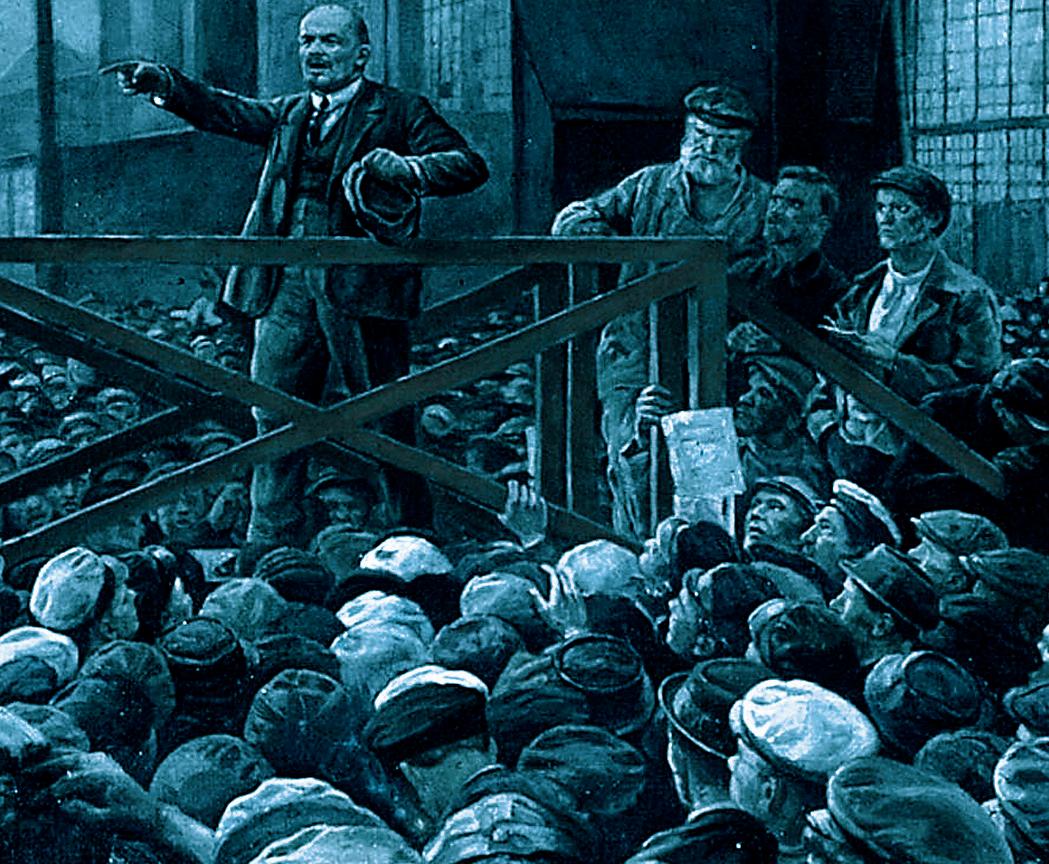

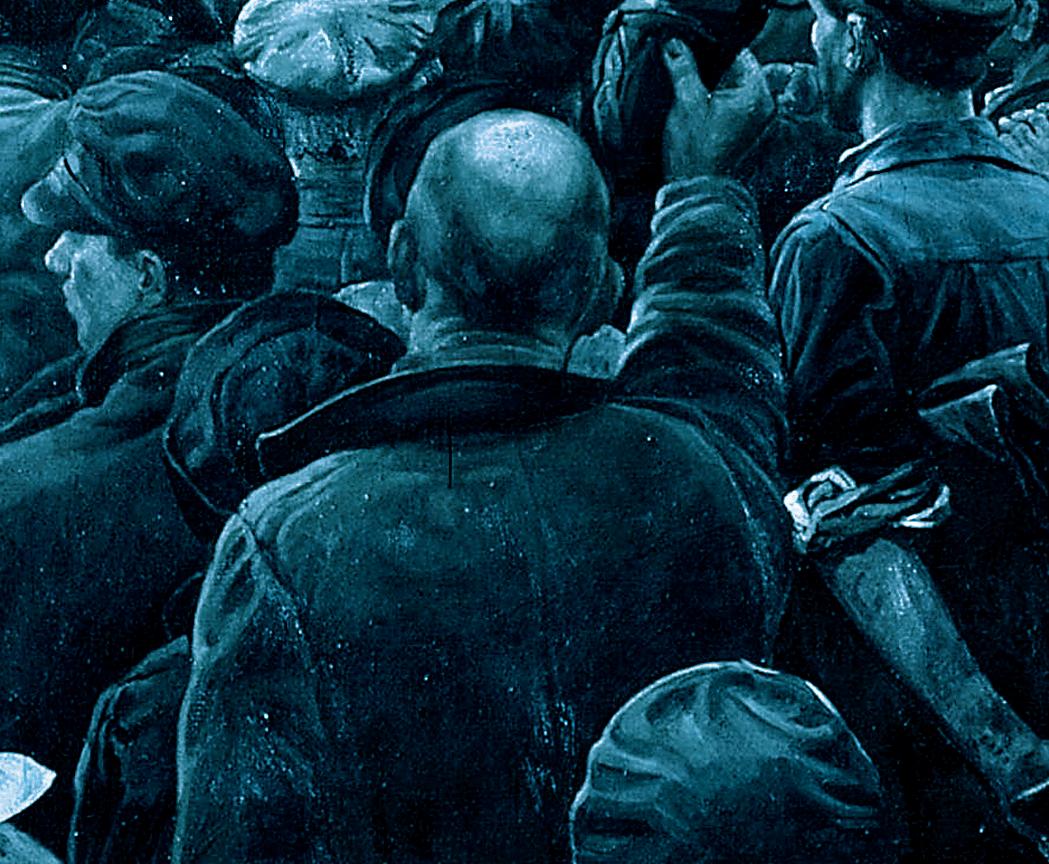


CAMBRIDGE INTERNATIONAL AS LEVEL HISTORY: TEACHER’S RESOURCE
Introduction
About the authors
How to use this series
How to use this Teacher’s Resource
About the syllabus
About the assessment
Lesson plan template
Approaches to learning and teaching
Teaching notes and supporting resources
European option: Modern Europe, 1774–1924
Chapter 1: France, 1774–1814
Chapter 2: Liberalism and nationalism in Germany, 1815–71
Chapter 3: Russia from autocracy to revolution, 1855–1924
International option: International History, 1870−1939
Chapter 1: Imperialism and the emergence of world powers c.1870–1918
Chapter 2: International relations 1919–29: conflict and cooperation
Chapter 3: International history 1929–39: the rise of extremism and the road to war
Copyright
Endorsement statement
Glossary: European option
Glossary: International option
Acknowledgements
CAMBRIDGE INTERNATIONAL AS LEVEL HISTORY: TEACHER’S RESOURCE
This Teacher’s Resource contains both general guidance and teaching notes to help you to deliver the content in our Cambridge resources.
There are teaching notes for each chapter of the Modern Europe and International History Coursebooks. Each set of teaching notes contains the following features to help you deliver the chapter content:
At the start of each chapter there is a chapter plan. This provides an outline of the learning content and the relevant downloadable resources for each section.
The background knowledge feature explains the prior knowledge required to access the chapter and gives suggestions for addressing any gaps in your students’ understanding.
The language support box provides advice about terms that your students might find challenging or confusing within the chapter and suggestions for how to support students with English as an additional language.
SUPPORT
A common misconceptions table identifies common misconceptions that students may have about the topic and suggests how you can overcome these.
At the start of each section, a learning plan table includes suggested learning intentions and success criteria for that key question. It can be helpful to share these with your students so they can take responsibility for their own learning.
• explore how the Enlightenment motivated the French Revolution
• outline the ideological influences on the French Revolution
• consider how problems related to politics and finances increased criticism of the monarchy
• reflect on the course and consequences of the French Revolution.
• analyse the arguments against the political and financial policies of the monarchy
• evaluate the course and consequences of the French Revolution.
For each section in the chapter, there is a selection of Starter ideas, Main teaching ideas and Plenary ideas You can pick out individual ideas and mix and match them depending on the needs of your class. They are designed to be used flexibly within your own teaching plan and supplement the activities and other features within the coursebook. Suggested timings for these activities have been given, but depending on how you choose to use them, you may find that they take more or less time. The main teaching ideas include suggestions for how they can be differentiated or used for formative assessment. Homework ideas are also provided.
1 What do you know about types of governments? (20 minutes)
Resources: Device with internet access
Purpose and description: The purpose of this activity is to allow students to measure how much existing knowledge they have of various political systems relevant to this chapter (they should have at least some basic knowledge of some of these political systems). This lesson should be delivered before the first lessons covering Coursebook Section 1.1.
Divide students into small groups and assign each group one of the following political systems:
• monarchy
• republic
• democracy
• theocracy
• oligarchy
• dictatorship.
Ask groups to use the internet to research each system and take bullet-point notes on what they find out.
To get students started, you could ask them:
• How does this political system work?
• Where has it been tried?
The resources for each chapter include worksheets and their respective answers. Topic worksheets provide students with extra practice on key skills like constructing arguments and source analysis while the language worksheets help students to develop their vocabulary and improve their essay-writing skills.
6
© Cambridge University Press & Assessment 2025
You can also download additional resources including answers to the Coursebook activities and practice questions, source files with all the figures in the Coursebooks extracted into pdf files for annotation and more accessible viewing and glossaries for the Coursebooks.
2025
Section Outline of learning content
2.1 Why was there such extensive dissatisfaction with the peace settlements of 1919–20?
2.2 Why was the League of Nations created and what challenges did it face in the 1920s?
• The negotiations at Versailles, including
• key issues in agreeing the treaties, including
• the aims of the Big Three
• representation of other powers
• key terms of the Treaties of Versailles, Trianon, Neuilly, Saint Germain, and Sèvres.
• Difficulties created by the treaties, including
• boundaries created by the settlements
• inconsistent application of national self-determination.
• Reactions of victors and defeated powers
• France, Britain, USA, Italy, Japan, Germany
• position of Russia.
• Reparations
• the question of ‘war guilt’
• the issue of size and payment.
• Creation of the League, including
• Wilson’s Fourteen Points
• inclusion in all the treaties
• aims and structure.
• Weaknesses of the League, including
• restricted membership
• leadership
• voting processes
• enforcement difficulties.
• Collective security and the League’s involvement in the resolution of post-war disputes, including
• the Aaland Islands
• Teschen
• Polish seizure of Vilna
Downloadable worksheets
Section Outline of learning content
• the Upper Silesian Coalfields dispute
• Memel
• Greco–Bulgarian border dispute.
•Role and impact of the agencies, including
• the Commission for Refugees
• International Labour Organization (ILO)
•Slavery Commission
• Disar mament Commission
• Mandates Commission.
2.3 How and why did international tensions remain high after the Versailles settlement?
Downloadable worksheets
2.4 How and why did international relations improve from 1924–29?
• Crisis and tensions, including
•Fiume
•Corfu
• the Ruhr crisis
• German hyperinflation and the reparations issue
• ethnic, political and economic problems in the successor states.
• Aims and impact of international treaties and conferences, including
• Little Entente, 1921
• Washington Conference, 1921–22
• Genoa Conference, 1922
• Rapallo Pact, 1922
• Treaty of Lausanne, 1923.
• Changing relations between the major powers, including
• European nations: Britain, France, Germany, Italy
•the Soviet Union and the challenge of communism
•the USA: isolation or involvement
• emergence of Japan–inter nal issues and the effect on international relations.
• Economic recovery and improved relations, including
• Dawes Plan–proposals and effect on inter national relations
• Stresemann and Germany recovery
• Ger man entry into the League of Nations
• Young Plan.
Language worksheet 2.2
Topic worksheet 2.3
Topic worksheet 2.4
Topic worksheet 2.5
Topic worksheet 2.6
Topic worksheet 2.7
Section Outline of learning content
• Aims and impact of international proposals, treaties and conferences, including
• Geneva Protocol,1924: support and opposition
• Locarno Treaties, 1925: achievements and failures
•Kellogg–Briand Pact, 1928: purpose and limitations
• Hague Conference,1929, and the dispute over evacuation of the Rhineland.
• Developing relations between the major powers, including
• France and Germany: the role of Stresemann and Briand
• Italy and the impact of Mussolini’s ambitions on inter national relations
• shifting relations with the Soviet Union.
• Improved relations: reality or illusion, including
• European powers
• Japan and USA
• immediate impact of the Wall Street Crash.
• This chapter begins with the peace negotiations following the First World War. Students may need to review the nations on each side of the war and the events toward the end of the war. This YouTube video ‘Geo History: World War I’ provides a summary of the First World War with map visuals.
•It would be helpful to assess what students already know about different for ms of gover nment, including their understand of communism, democracy and monarchy. Ask students to define these ter ms on their own. Then, discuss the correct answers and explain to students that these are just a few of many
Downloadable worksheets
different possible forms of government. You may want to show a video, such as this YouTube video ‘Every form of government explained in 8 minutes’, that reiterates the definitions, as well as introducing the many varieties of government they might encounter in historical study.
• Students will need an understanding of European geography to master the content in this chapter. It would be useful to assess their geographical knowledge and, if needed, emphasise geography in some of the chapter’s topics (such as the loss of land by the former empires to the successor states).
• Many of the key words in this topic are related to politics or economics. Students will have varying levels of existing knowledge regarding these terms, from complete understanding to total unfamiliarity. Successful students will be able to use these terms accurately in a written response.
• Self-determination refers to the principle that people of common nationality should have the right to form their own nations and govern themselves. Wilson’s definition of a ‘nationality’ (based on common language) was both too simplistic and inappropriate for the situation in Eastern Europe at the end of the First World War.
• Collective security refers to the idea that if any member state of the League of Nations was threatened, all the other member states would work together to defend it.
• Disarmament refers to reducing the size of armies, navies and air forces, as well as certain types of weapons, such as submarines and tanks.
• ‘Communists’ refers to all followers of Marxist ideals. The Bolsheviks were the group of communists who seized power in Russia 1917 and then established the
Misconception
Students sometimes equate the actions/ideas of independent nations with the actions/ideas of the League of Nations.
Soviet Union, but the two terms do not mean the same thing.
• ‘Soviet Union’ or ‘USSR’ (Union of Soviet Socialist Republics) refers to the state created by the Bolsheviks.
• ‘Russia’ refers to either the country known as Russia that was a monarchy before the revolution began in 1917 or to the post-1991 country known as Russia that exists today. Students should avoid using Russia interchangeably with Soviet Union or USSR.
• Ask students to complete Language worksheet 2.1 after covering the content in Section 2.2. It will assist students with consolidating their understanding of the language of international relations in the early 1920s. Students may use a dictionary to support them as they complete this worksheet.
• Language worksheet 2.2 provides models of sentences that effectively compare and contrast, and also allows students to practise building sentences that discuss comparisons. Ask students to complete this worksheet after covering the content in Coursebook Section 2.3, but before they attempt to answer the practice questions at the end of the chapter.
Ask students to identify the major events that the League of Nations was involved with during the 1920s. If they respond with an event the League was not involved in, such as the Washington Naval Conference or the Kellogg–Briand Pact, then they are confusing the role of the League of Nations with the independent actions of nations that may be members of the League.
Explain to students that while some nations shared the same desires as those expressed in the League of Nations’ covenant, the League was not involved in every major international event of the 1920s. Ask students to make a comparison table with the events that the League was involved in alongside those it was not involved in.
Misconception How to identify How to overcome
Many students do not understand the way that a communist government functions or why this would be considered a threat to democratic European powers.
Ask students to explain how a communist government is structured. If students find it difficult to answer at all, or give incorrect answers, then they need a refresher about the basics of Marxism / communism as well as the ways in which this differs from many of the other major powers’ government structures.
Explain to students the basic ideas of Marxism and how this is a different interpretation of economic and government structures from those held by most of the European powers in 1917. Then, explain to students how Marxism shaped the government structure of the USSR. Next, ask students to make a comparison table of the major powers’ government structures in the 1920s.
2.1 Why was there such extensive dissatisfaction with the peace settlements of 1919–20?
Key question
Why was there such extensive dissatisfaction with the peace settlements of 1919–20?
Learning intentions Students will:
•examine the problems faced by peacemakers in 1919
•study the solutions to the problems peacemakers faced during negotiations
•explore the terms of the peace treaties
•learn about the causes of opposition to the peace treaties.
1 Who determines the details of peace? (20 minutes)
Success criteria Students can:
•explain the problems faced by peacemakers in 1919
•discuss the solutions peacemakers proposed to the problems they faced during negotiations
•identify the terms of the peace treaties
•analyse the causes of opposition to the peace treaties.
Purpose and description: The purpose of this activity is to encourage students to engage with their previous knowledge from Chapter 1 to think about problems that might emerge at the Paris Peace Conference. This activity should be done after the Chapter 1 lessons on the First World War.
Put students into small groups and encourage them to use their notes about the causes and course of the First World War to answer the question: ‘Based on what you know about the First World War, who should have been allowed to negotiate the details of the peace treaties, and why?’
Ask each group to share their thoughts with the entire class. Then ask the class if there was any type of consensus.
Differentiation:
• Challenge: Ask students who are confident in this material to predict the wants of each of the victorious nations at the Paris Peace Conference and explain why they would have those desires.
• Support: Provide students who need additional support with a video, such as this YouTube video, ‘Who Started World War 1’, reviewing the causes of the war.
2 What can this map tell us? (10 minutes)
Purpose and description: The purpose of this activity is to reinforce students’ knowledge of maps and geography, as well as to encourage them to predict the causes of border changes.
Show students this Map of Europe in 1923, which shows the border changes in Europe following the end of the First World War, but do not tell students this contextual information.
Ask students to pair up with a neighbour and answer the following questions:
• What does this map show?
• What does it tell us about what happened in the peace settlements after the war ended?
• Why do you think this might have happened? What factors might have influenced how those agreeing the peace settlements decided this map would look?
1 Weighing evidence and making a judgement (60 minutes)
Resources: Chart paper and markers
Purpose and description: The purpose of this activity is to help students to weigh historical evidence in order to make a judgement. This is a two-step activity that begins with a group activity, where you will ask students to first outline a balanced argument, and then make a judgement and explain that judgement in an individual reflection. The individual assessment will allow you to measure students’ progress towards mastery.
Break down the topic prompt for this lesson with the students as a group. The question they will be addressing is: ‘Was Woodrow Wilson the architect of the Paris peace settlement?’ This requires students to focus on the role of leaders, such as Wilson, in shaping the outcome of the Paris peace treaties, and asks them to measure the contributions of Wilson. In order to measure his influence, students must first be able to identify the ideas/desires of Wilson, and then decide how many of those ideas/desires were present in the treaties produced by the conference. Wilson’s ideas included:
• ‘Peace Without Victory’: he did not want to punish the defeated nations harshly
• self-determination
• disarmament
• adjustment of borders
• creation of new nations
• creation of a League of Nations
• evacuation of territory occupied by the defeated powers’ armies.
Divide students into small groups of no more than three and provide each group with chart paper and markers. Ask each group to create the following table to weigh the historical evidence for the following prompt:‘Many historians argue that Woodrow Wilson was the main architect of the Paris peace settlement. How accurate do you think this statement is?’ On one side of the table will be historical information that supports the idea that he played the main role in shaping the Paris peace treaties, while on the other side will be historical information that challenges this idea.
Evidence that supports the idea that Woodrow Wilson was the architect of the Paris peace settlement
Evidence that challenges the idea that Woodrow Wilson was the architect of the Paris peace settlement
Afterwards, ask the groups to write a short paragraph response that answers the question.
Answers:
Students may provide the following in their responses:
Evidence that supports the idea that Woodrow Wilson was the architect of the Paris peace settlement
• Some new nations were created that reflected Wilson’s emphasis on selfdeter mination, including some of the successor states such as Czechoslovakia.
• Evacuation of French territory and the restoration of the Alsace–Lorraine to France.
• An independent Polish state was created.
• The League of Nations was created, which was a key part of W ilson’s Fourteen Points, and it emphasised disar mament.
• The settlement adjusted borders.
• The settlement restored territory to places like Belgium.
Differentiation:
Evidence that challenges the idea that Woodrow Wilson was the architect of the Paris peace settlement
• Ger many was punished very harshly in the Treaty of Versailles, including signing the ‘War Guilt Clause’, forced disar mament, losing its colonies, restrictions of Anschluss.
• Defeated nations were forced to pay reparations challenging Wilson’s idea of ‘Peace W ithout Victory’.
• Self-determination was only applied to certain groups / areas and not applied to others (such as the areas that became mandates rather than becoming independent nations).
• Challenge: Ask students who have mastered this exercise to produce a response to the prompt: ‘Many historians argue that Woodrow Wilson was the main architect of the Paris peace settlement. How accurate do you think this statement is?’
• Support: If students are finding it difficult to identify historical evidence, make this activity open book and/or open notes to allow them to find the evidence. It may be useful to remind students that they do not have to wholly ‘pick a side’ in making their judgement, and that the degree to which they agree with the statement is important. Encourage students to use qualifiers or degree indicators to make a judgement more clearly. These words include (but are not limited to):
• complete/completely
• somewhat
• partially
• fully
• extremely
• slightly
• absolutely
• mostly.
Assessment ideas: This is a good opportunity to administer a reflective activity. Ask groups to post their tables in a visible place and then walk around the room and observe the tables of other groups. This is intended to expose students to other perspectives and information that their group may have missed. Then ask them to write their individual responses, indicating what they would change in their group’s response after viewing those of the other groups.
Resources: Topic worksheet 2.1, Coursebook Section 2.1, device with internet access, chart paper and markers
Purpose and description: This activity is designed to expose students to the reactions of the defeated and victorious powers to the Paris peace treaties.
Divide the class into pairs or small groups. Assign each group one of the following peace settlements to explore:
• Treaty of Versailles (agreed with Germany)
• Treaty of Saint Germain (agreed with Austria)
• Treaty of Neuilly (agreed with Bulgaria)
• Treaty of Sévres (agreed with Turkey)
• Treaty of Trianon (agreed with Hungary).
Ask each group to research the terms of the treaty they were assigned and the reactions to that treaty.
After completing their research, ask each group to make a poster about the treaty that allows to the viewer to understand:
• victorious powers’ reasons for dissatisfaction
• defeated powers’ reasons for dissatisfaction.
After each group has completed their poster, students will tour the room and complete Topic worksheet 2.1. Encourage them to use this worksheet to help them revise their knowledge.
Answers:
See Topic worksheet 2.1 Answers
Differentiation:
• Challenge: Ask students who have quick success with this activity to make a judgement about whether or not the Paris peace settlements could be considered ‘fair’.
• Support: Pair students who are finding this challenging with another student to complete the tour and worksheet.
Assessment ideas: Ask students to think about which poster they think was the most effective at conveying its information. Then, ask them to write their reasoning on a sticky note and put it on the poster they thought was the most effective.
1 Was the inclusion of the War Guilt Clause justified? (15 minutes)
Resources: Coursebook Section 2.1
Purpose and description: The purpose of this activity is to get students to make a judgement about the outcomes of the Paris Peace Conference, using their knowledge, gained from Coursebook Section 2.1.
Ask students to write a paragraph-length response to this question: ‘Was the inclusion of the War Guilt Clause justified’? They should include at least two specific pieces of evidence to support their argument. The recommended timing for this assignment may be adjusted based on the class’s writing abilities at this point in the course.
After students complete their paragraphs, you can use peer assessment to determine the effectiveness of the argument/evidence chosen.
Differentiation:
• Challenge: Ask students who are confident in this material to create a mock newspaper article, covering the outcomes of the Paris Peace Conference.
• Support: Provide students who are finding this material difficult with a list of sentence stems or transition words to help them construct their response. Some of these sentence stems may include:
• ‘The inclusion of the War Guilt Clause was/was not justified because …’
• ‘Germany should/should not have had to agree to the War Guilt Clause because …’
• ‘It was/was not justified that some of the victorious nations wanted to force Germany to sign a War Guilt Clause because …’
• ‘One reason that the War Guilt Clause was/was not justified was …’
• ‘________________ is another reason that the inclusion of this clause was/was not justified.’
Ask students to consider the following in their peer assessment:
• Did the response include a clear answer to the question?
• Does the response explain how the evidence included supports the argument?
• How could this response be improved? Ask students to suggest at least one way in their feedback to their peer.
Purpose and description: This activity is intended to allow both students and teachers to gauge what students have understood in Coursebook Section 2.1.
Ask students to spend some time making a total of five multiple-choice questions about what they learned in studying the section. Each question should have at least four answer options.
After students have composed their questions, instruct them to complete a series of rotations (how many is up to the teacher) where they pair up with another student. Each student will ask one of their questions for the other to answer.
After these rotations are complete, ask students to complete individual reflections that answer the following questions:
• Were there any topics you’ve found difficult in today’s activity?
• What makes a ‘good’ multiple-choice question?
• What makes a ‘bad’ multiple-choice question?
• Would you change any of the questions you wrote today? Explain your reasoning.
CAMBRIDGE INTERNATIONAL AS LEVEL HISTORY: TEACHER’S RESOURCE
Differentiation:
• Support: give students who are finding it challenging to write multiple-choice questions some information about question stems and writing multiple-choice answers. (This website, ‘Writing Effective Multiple Choice Questions’ is a good example).
Purpose and description: The purpose of this activity is to allow students to revise their knowledge from Coursebook Section 2.1 and condense it into a usable form of notes.
Ask students to prepare a ‘Top Ten Facts to Know’ about Coursebook Section 2.1. These can be bullet points but should be presented as complete sentences and should include specific information such as names, events, people and ideas.
Answers:
Students’ answers will vary, but an example bullet response may resemble this:
• The Treaty of Versailles caused much controversy because of its terms: it demilitarised Germany, took its overseas territories, forbade Anschluss, included a ‘war guilt’ clause, and required reparations. Some nations, such as the USA and Britain, found its terms too harsh. Others, like France, thought it was not harsh enough.
Purpose and description: The purpose of this activity is to encourage students to demonstrate what knowledge they have gained in Coursebook Section 2.1.
Ask students to prepare a one-page typed or handwritten response to the Key question for this section: ‘Why was there such extensive dissatisfaction with the peace settlements of 1919–20?’ In their response, they should include at least three causes. In the last paragraph, they should pick the most important cause and explain their reasoning. They must use specific information that includes dates, names, ideas and/or events.
Answers:
Students’ answers will vary, but they may include:
• Feelings that the treaties were too harsh on the defeated powers and/or feelings that the treaties were not harsh enough.
• Concerns about the impacts of reparations.
• Italy feeling that it did not receive the lands it was promised.
• Russia and Germany being upset that they did not get to participate in negotiations.
• Disputes over the creation of the League of Nations.
• The many problems the successor states faced that resulted from the decisions made in Paris.
• Uneven application of key ideas such as self-determination.